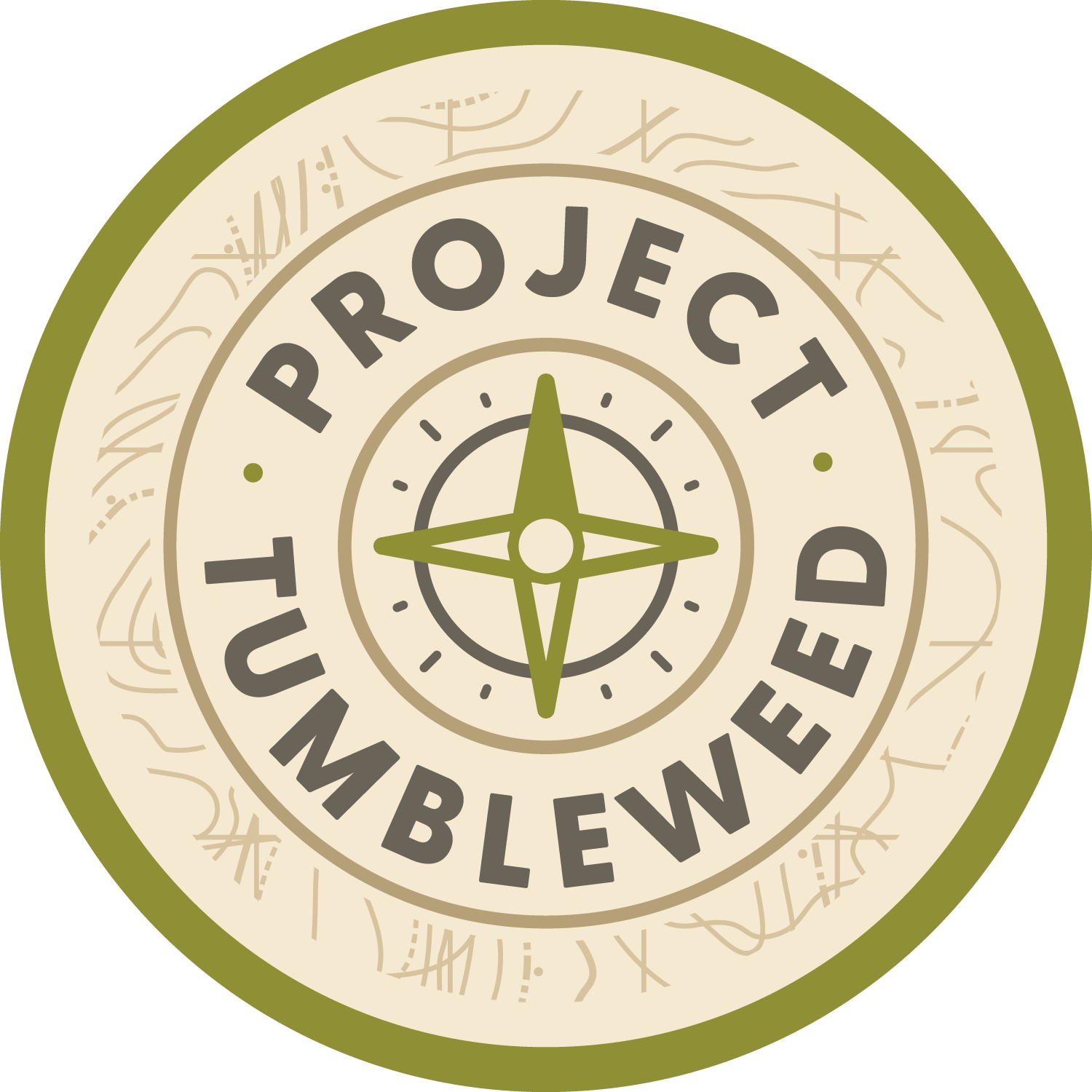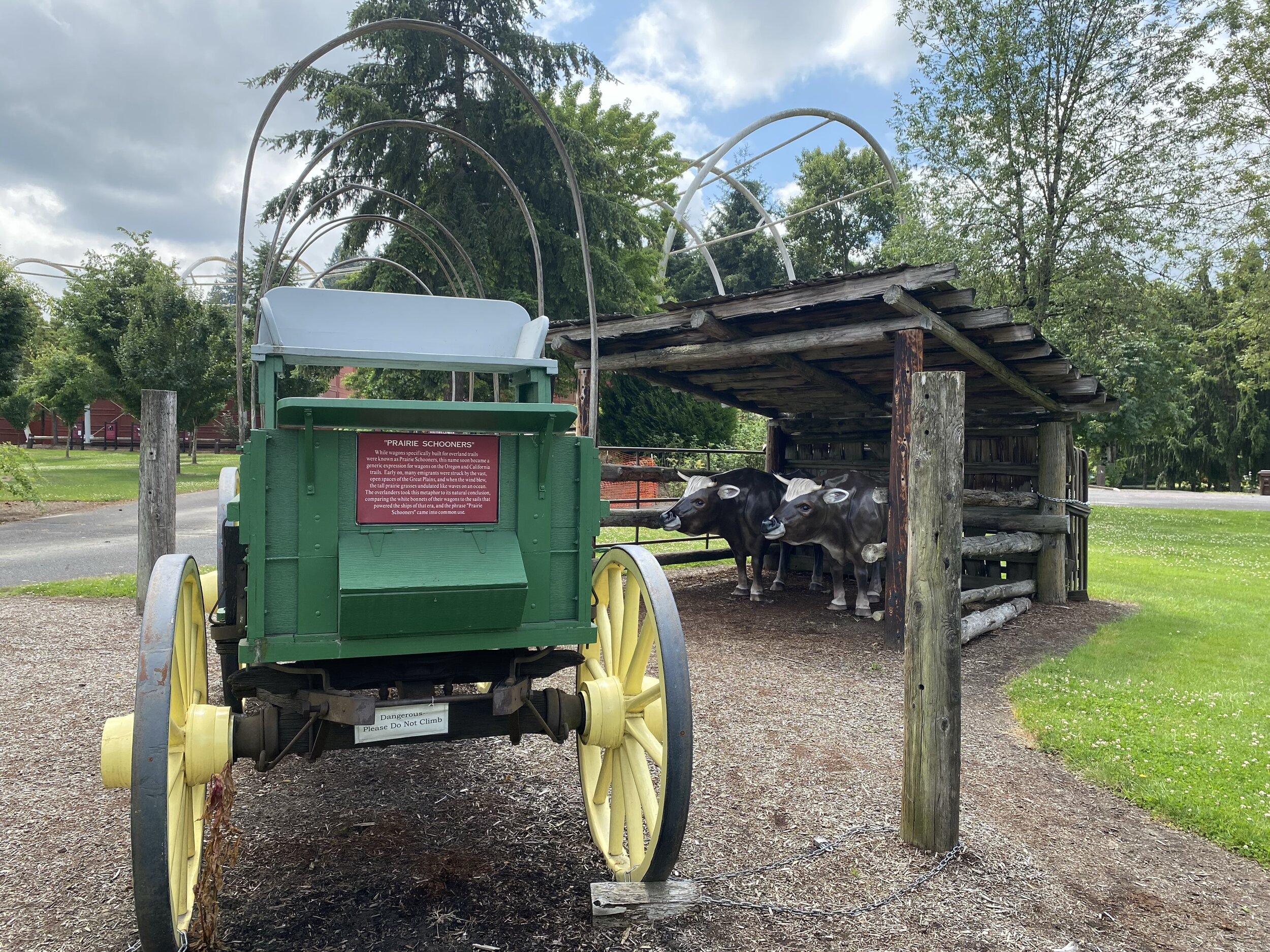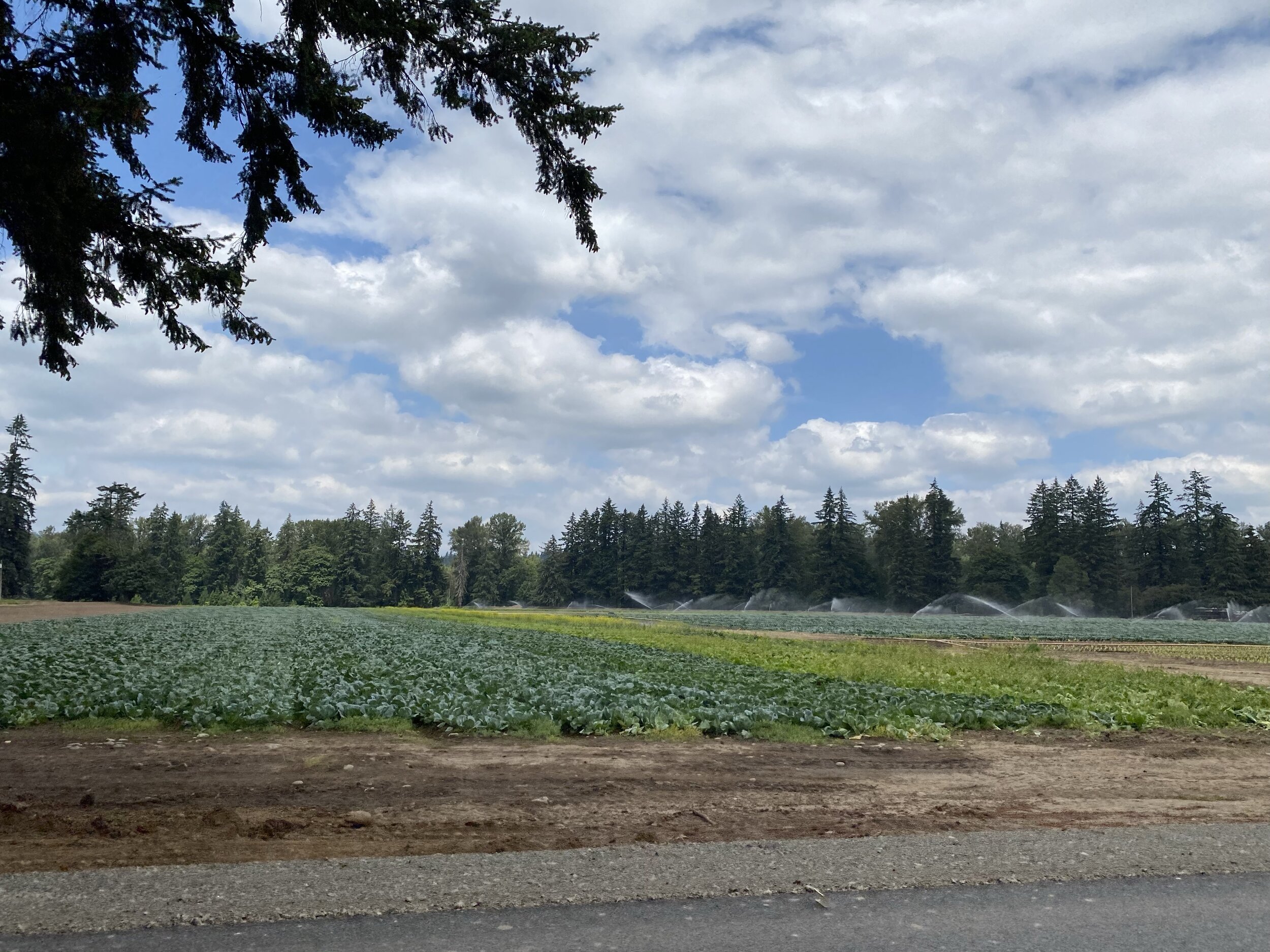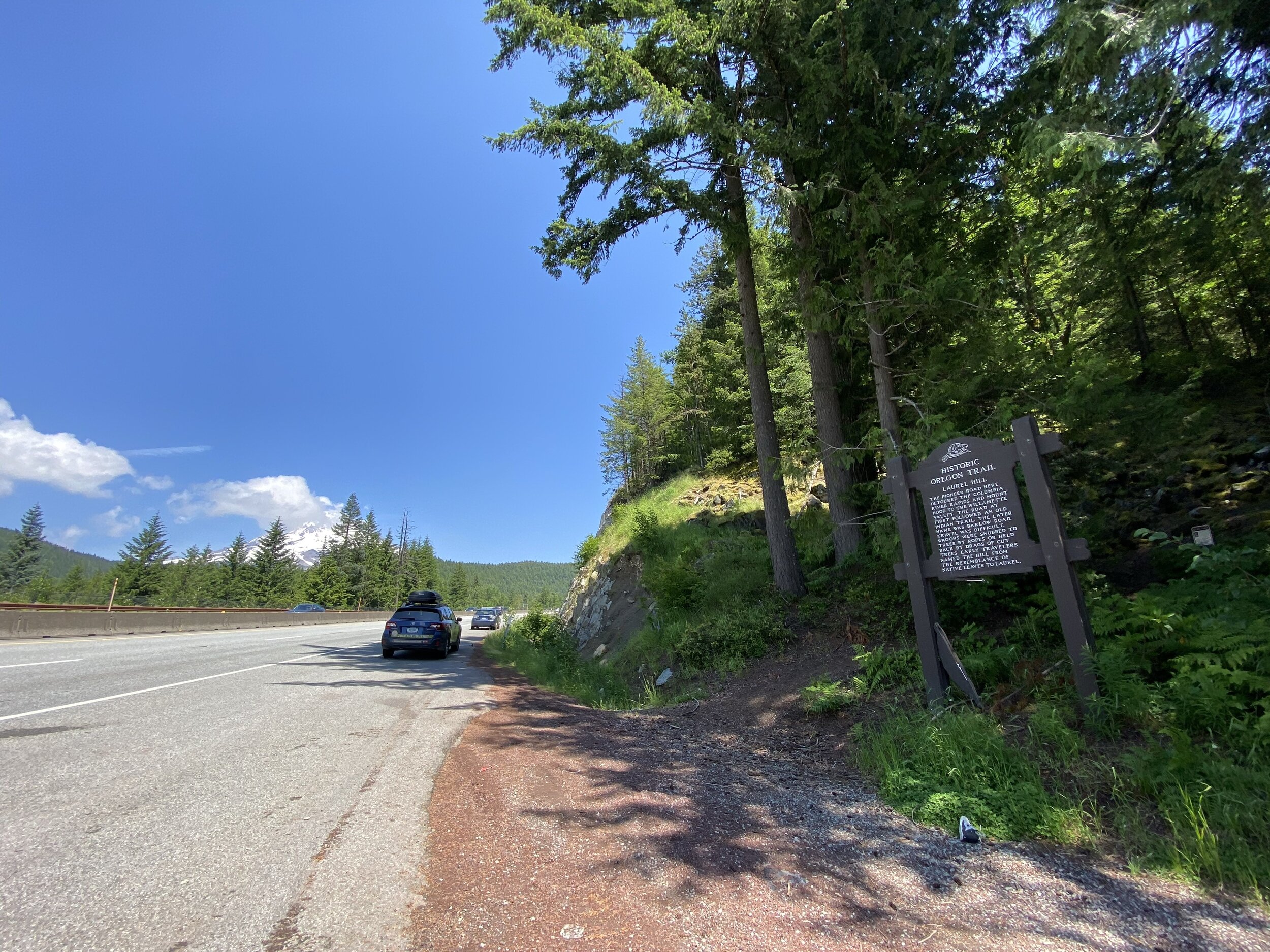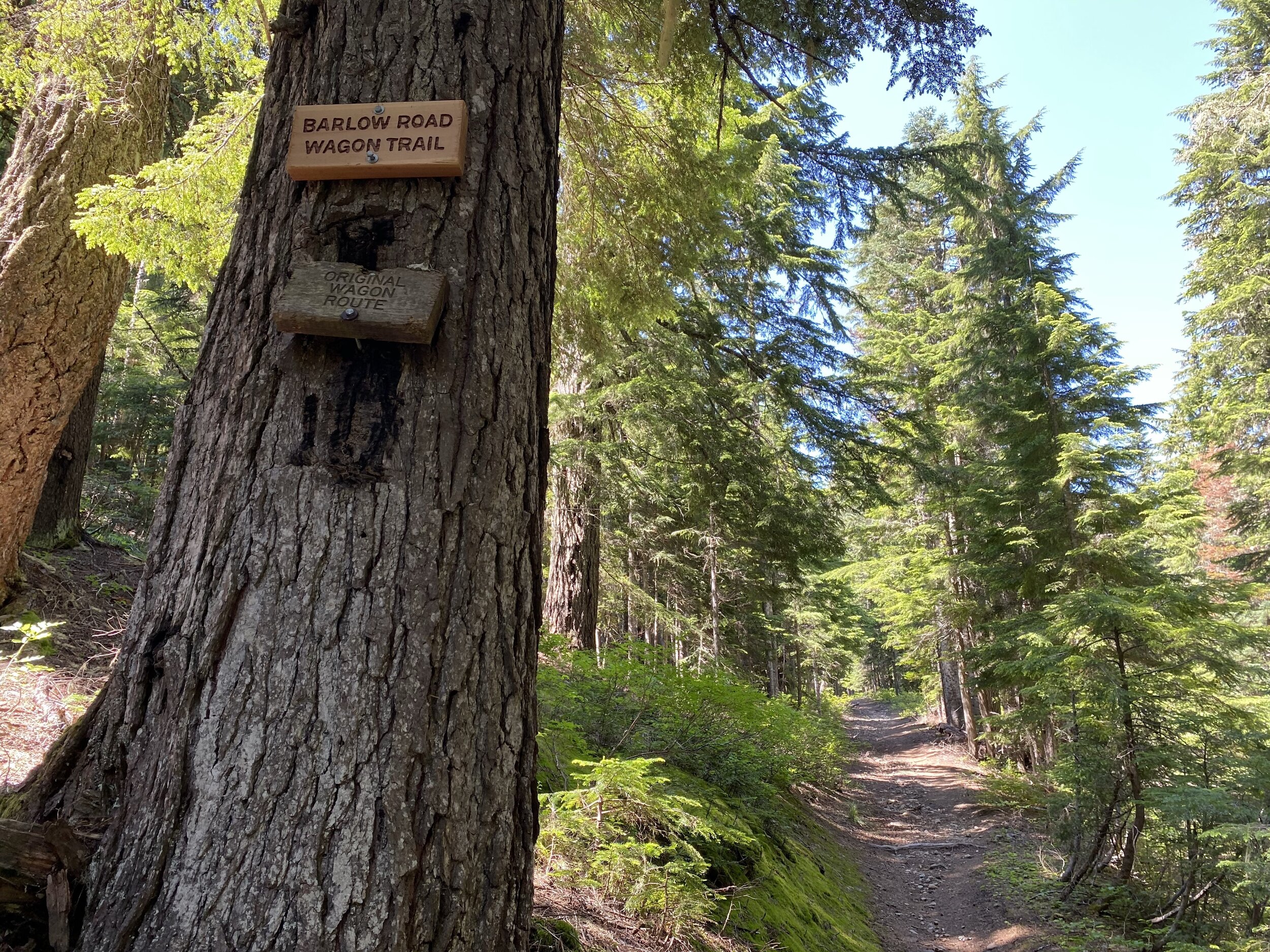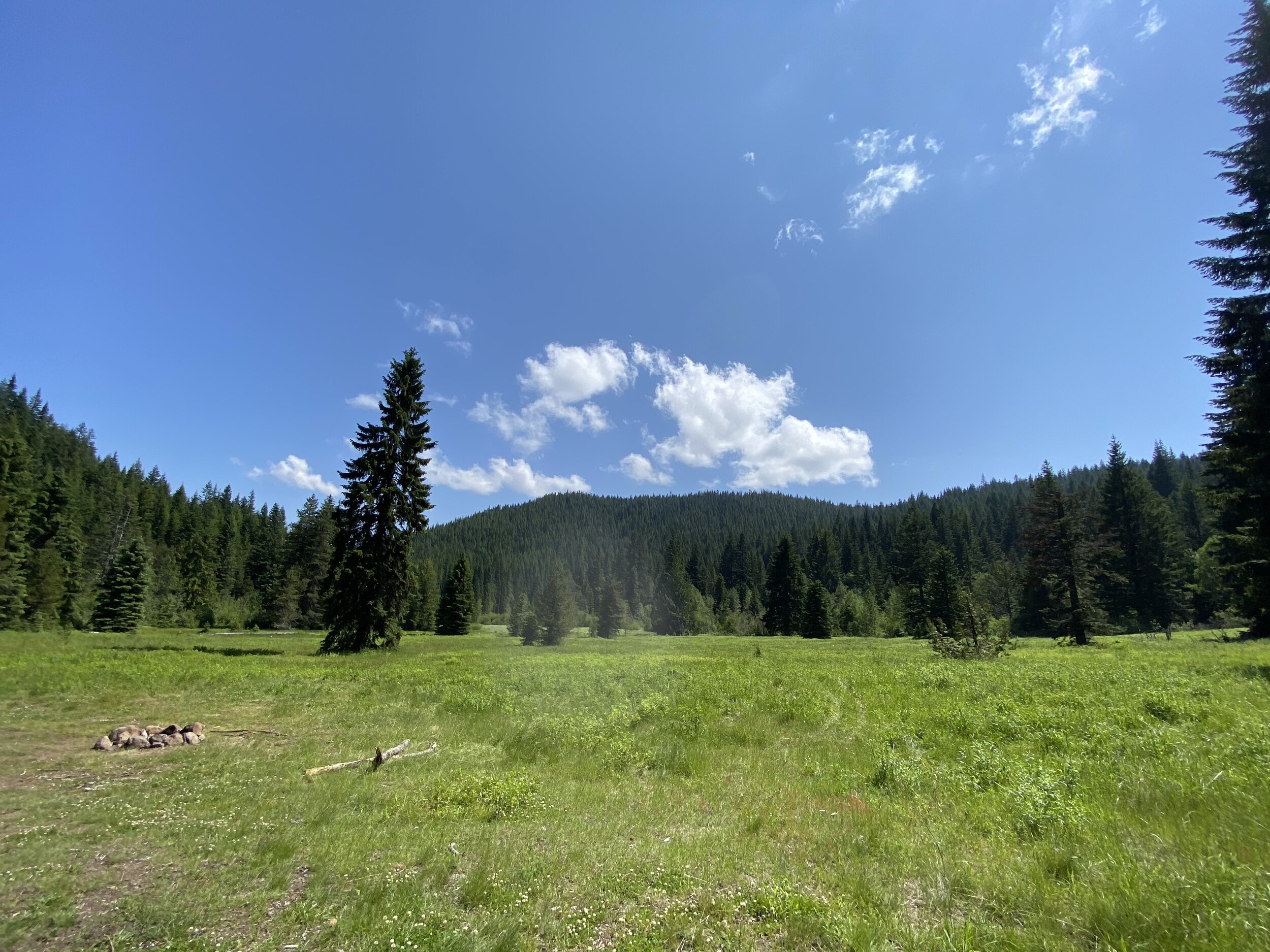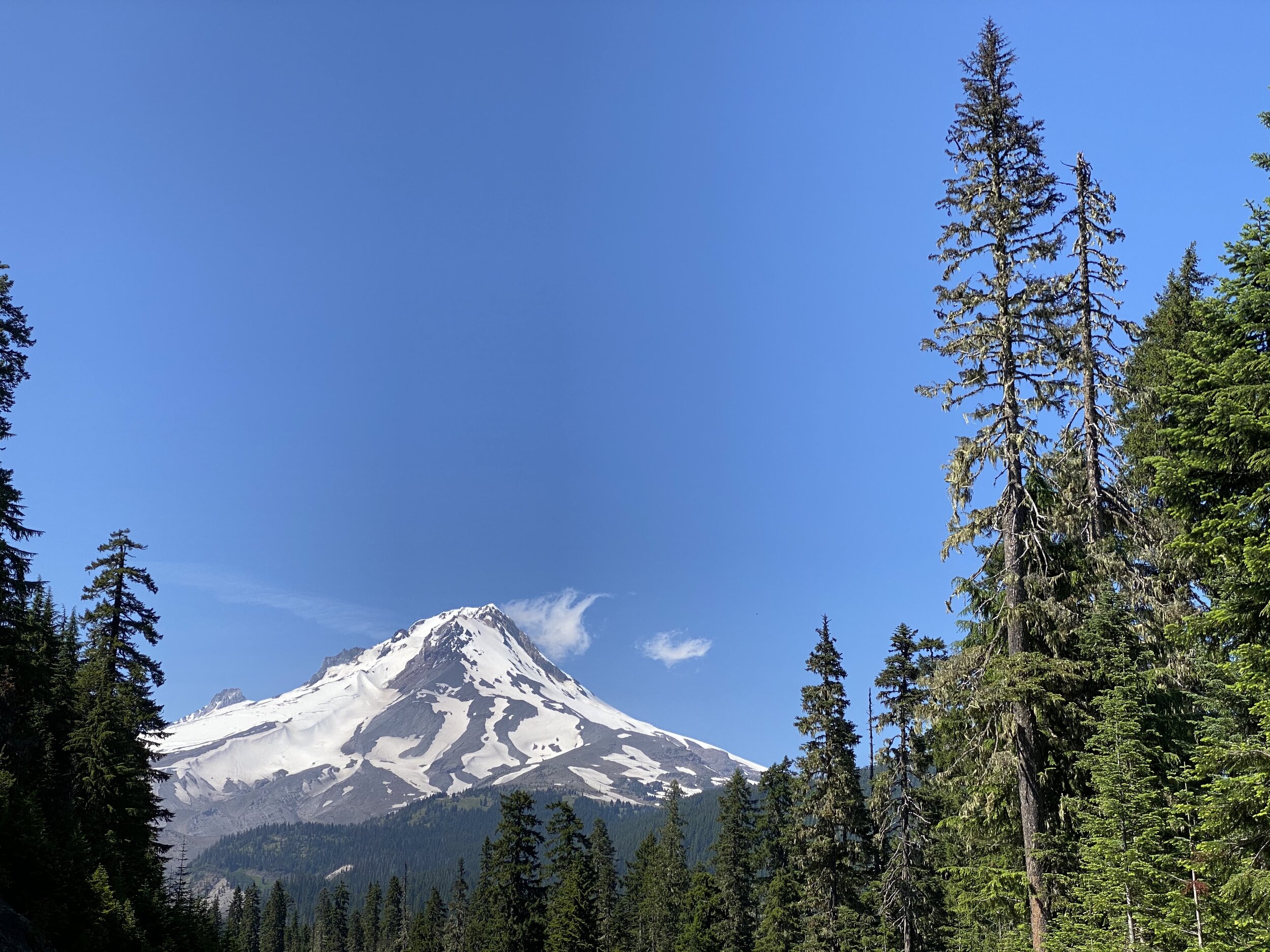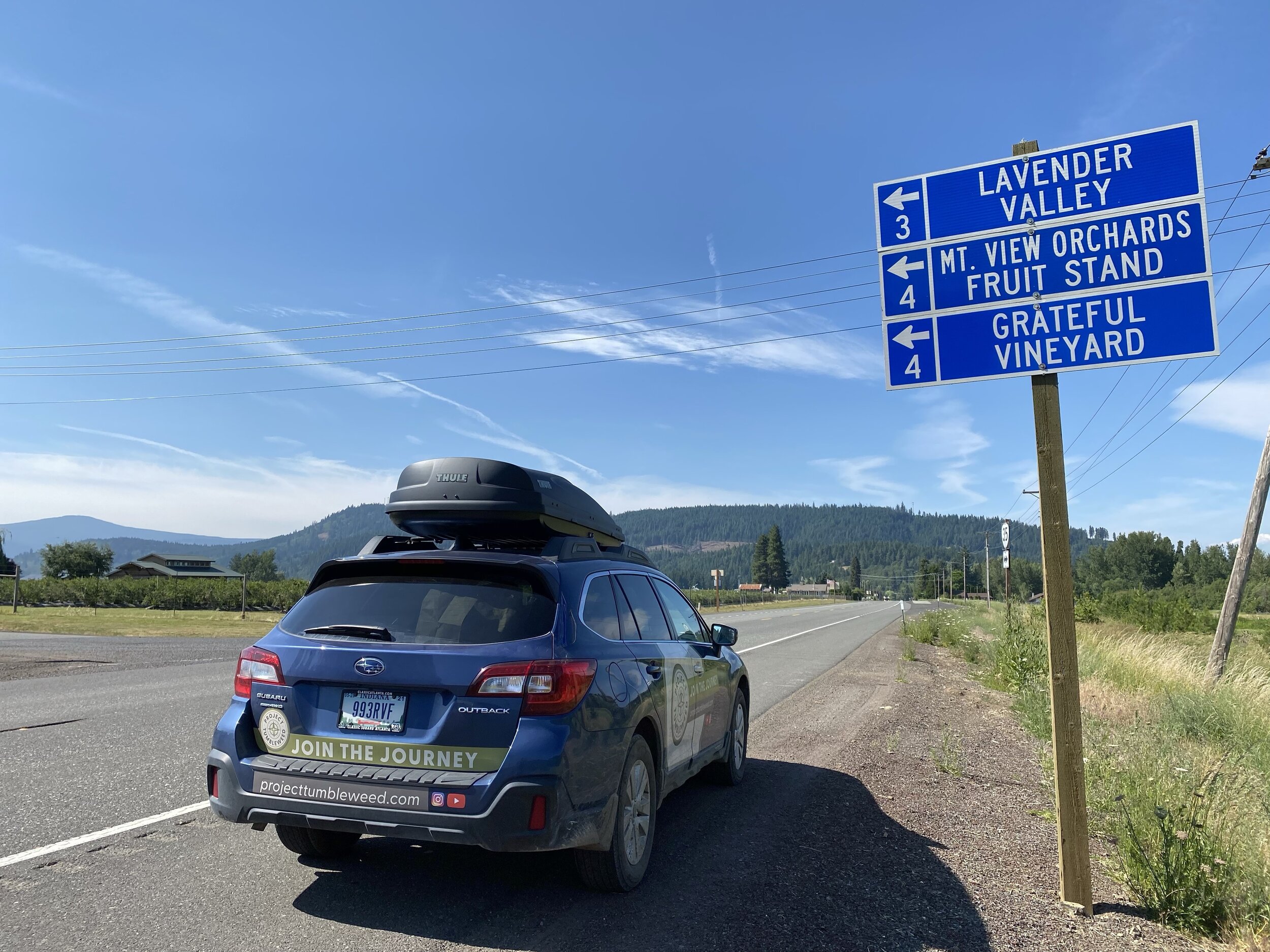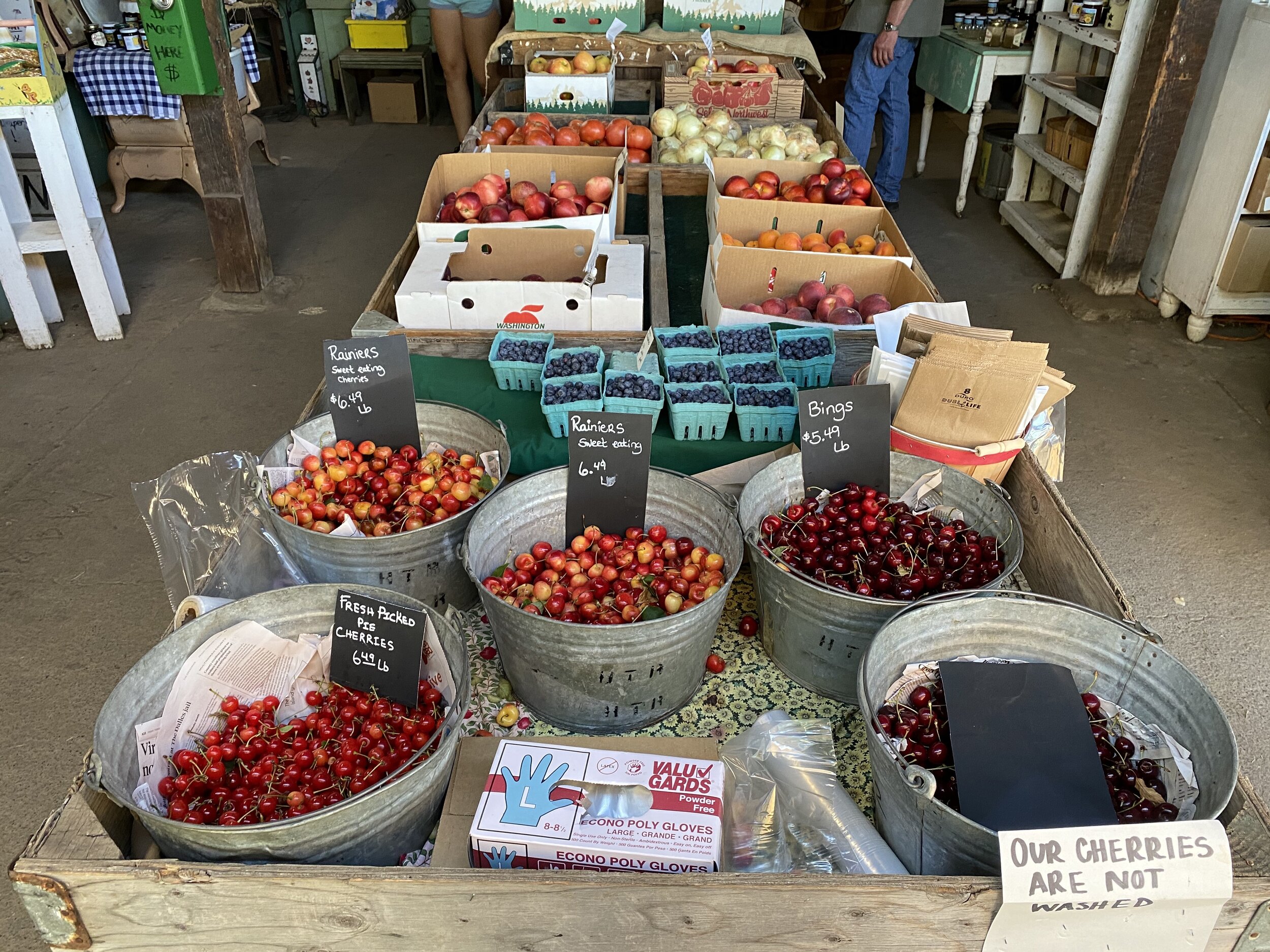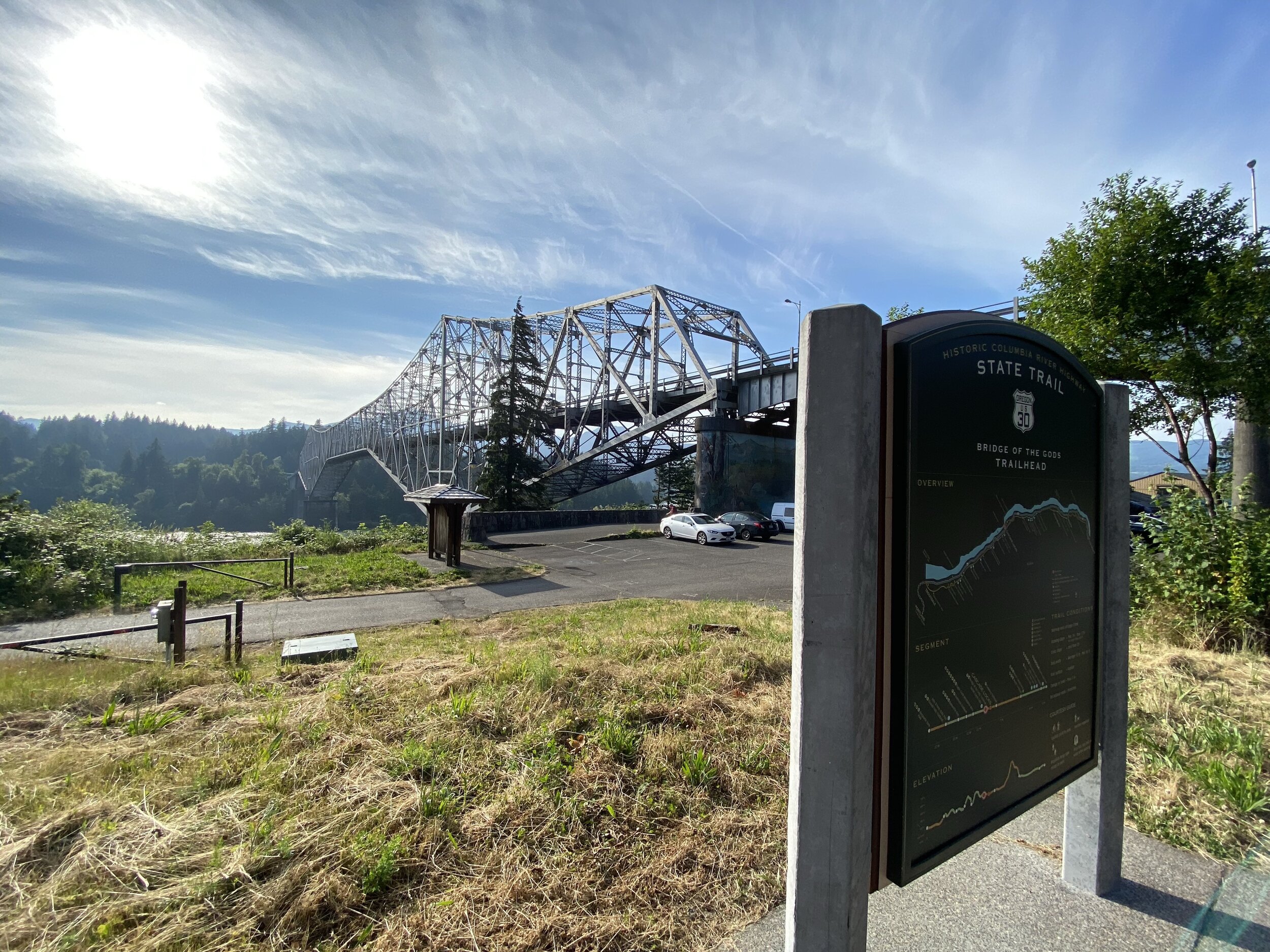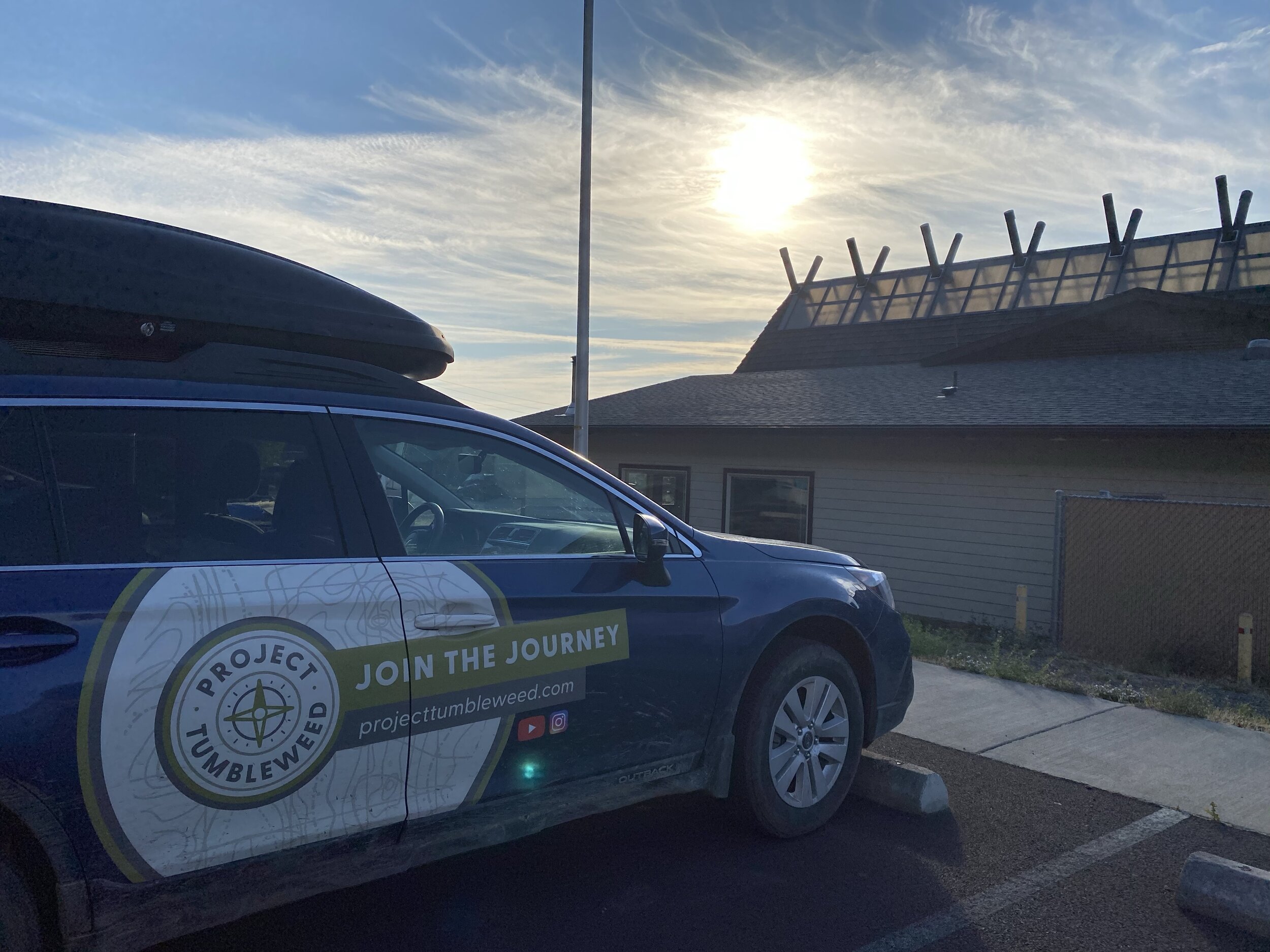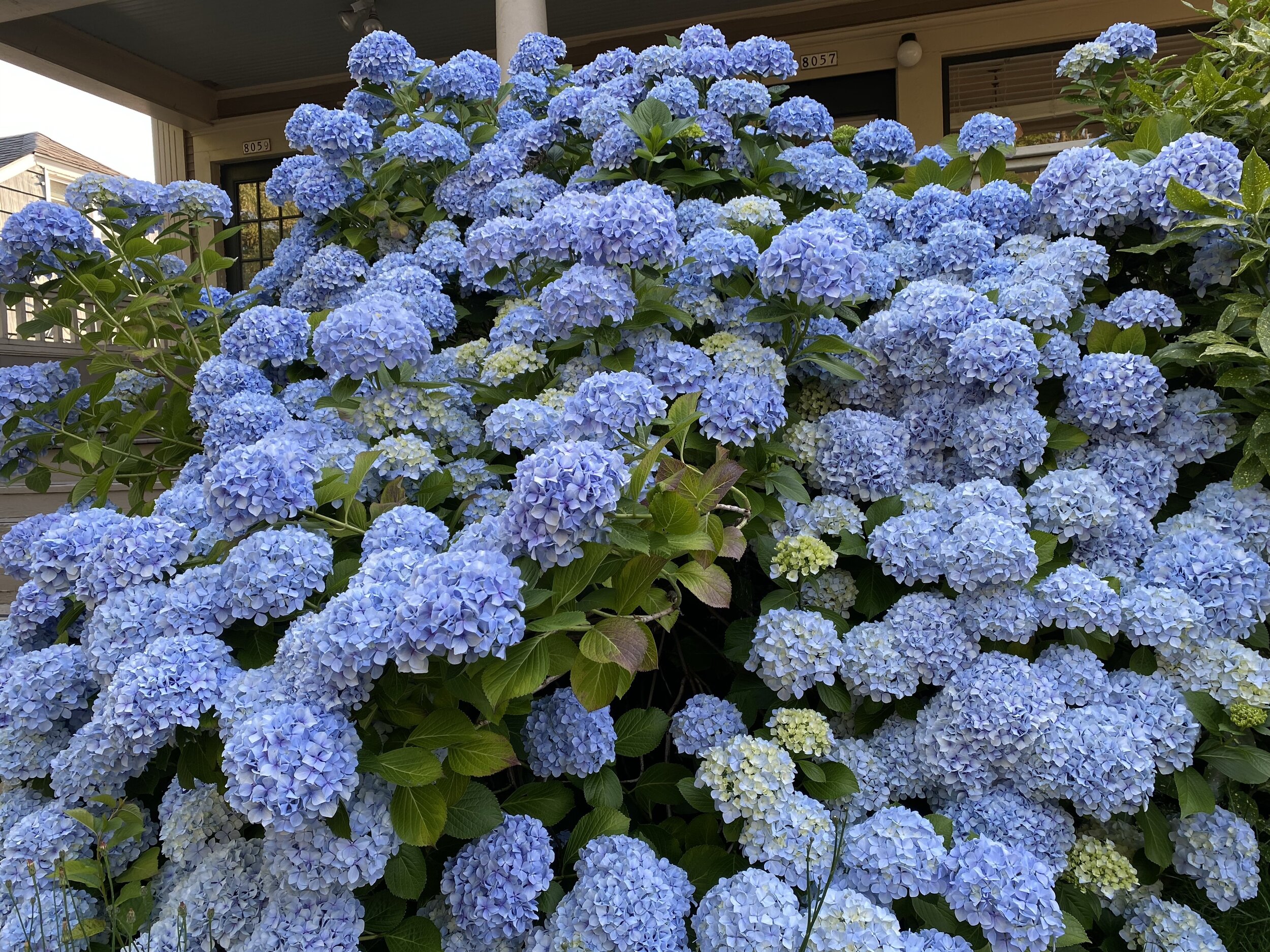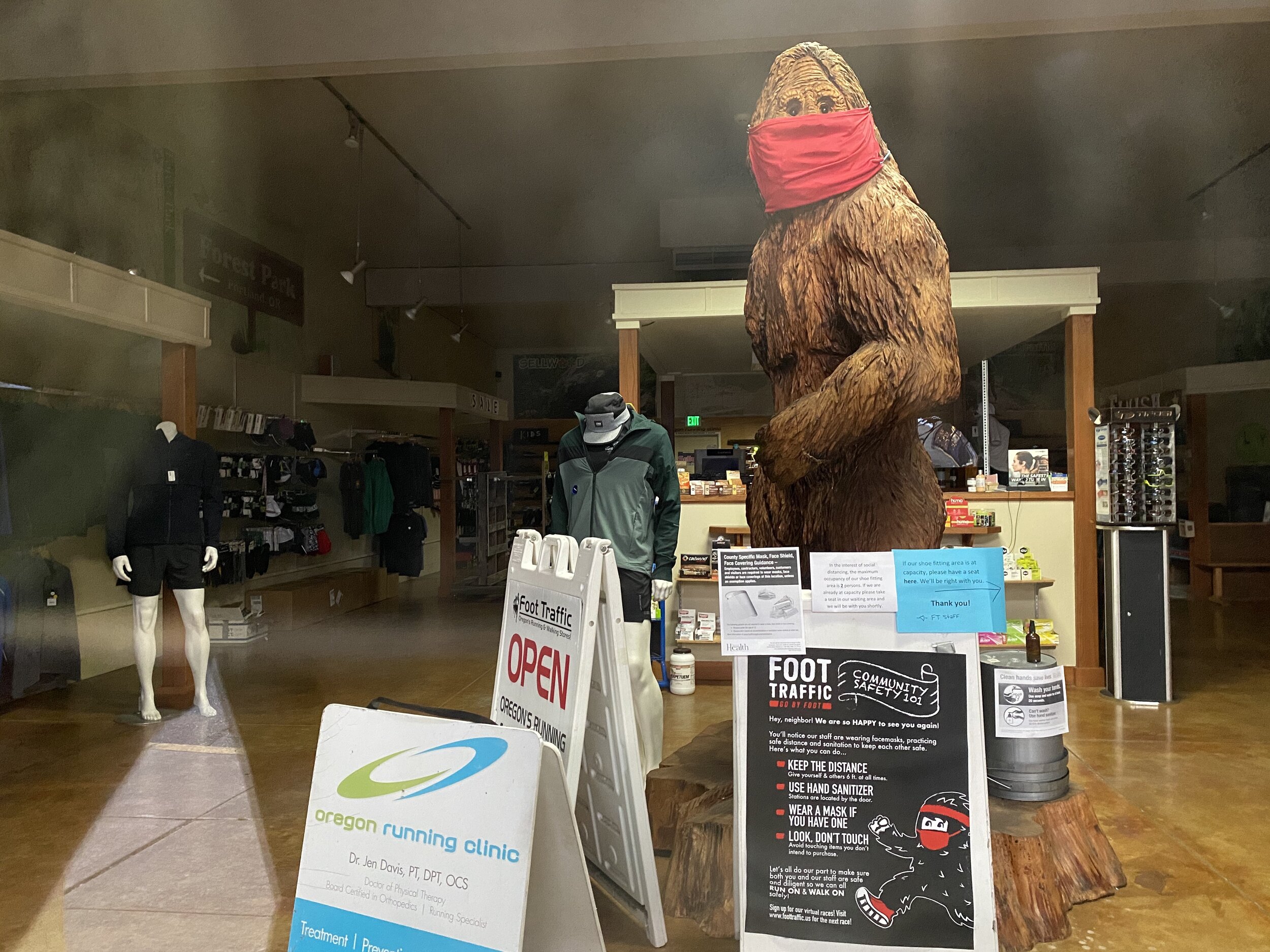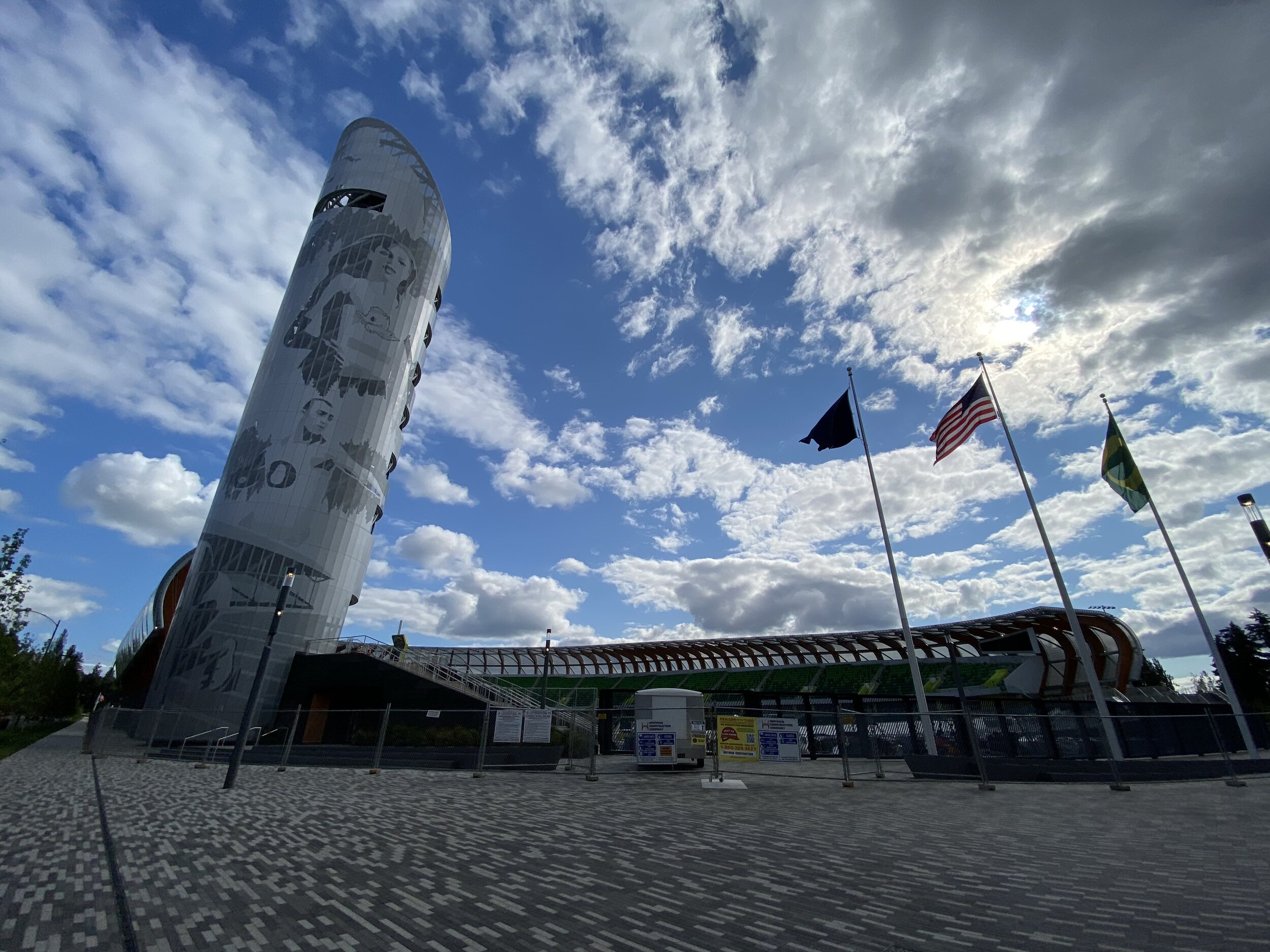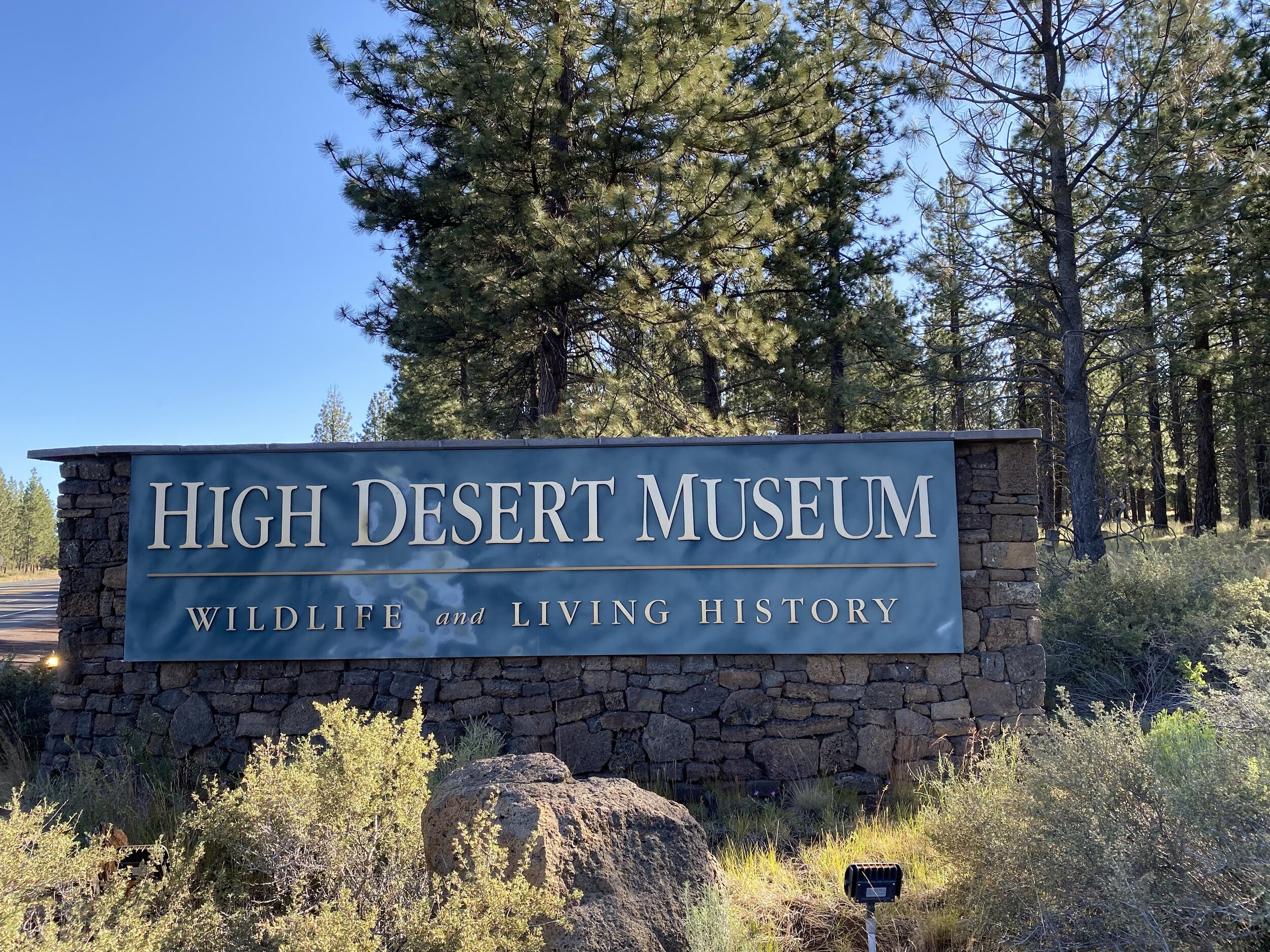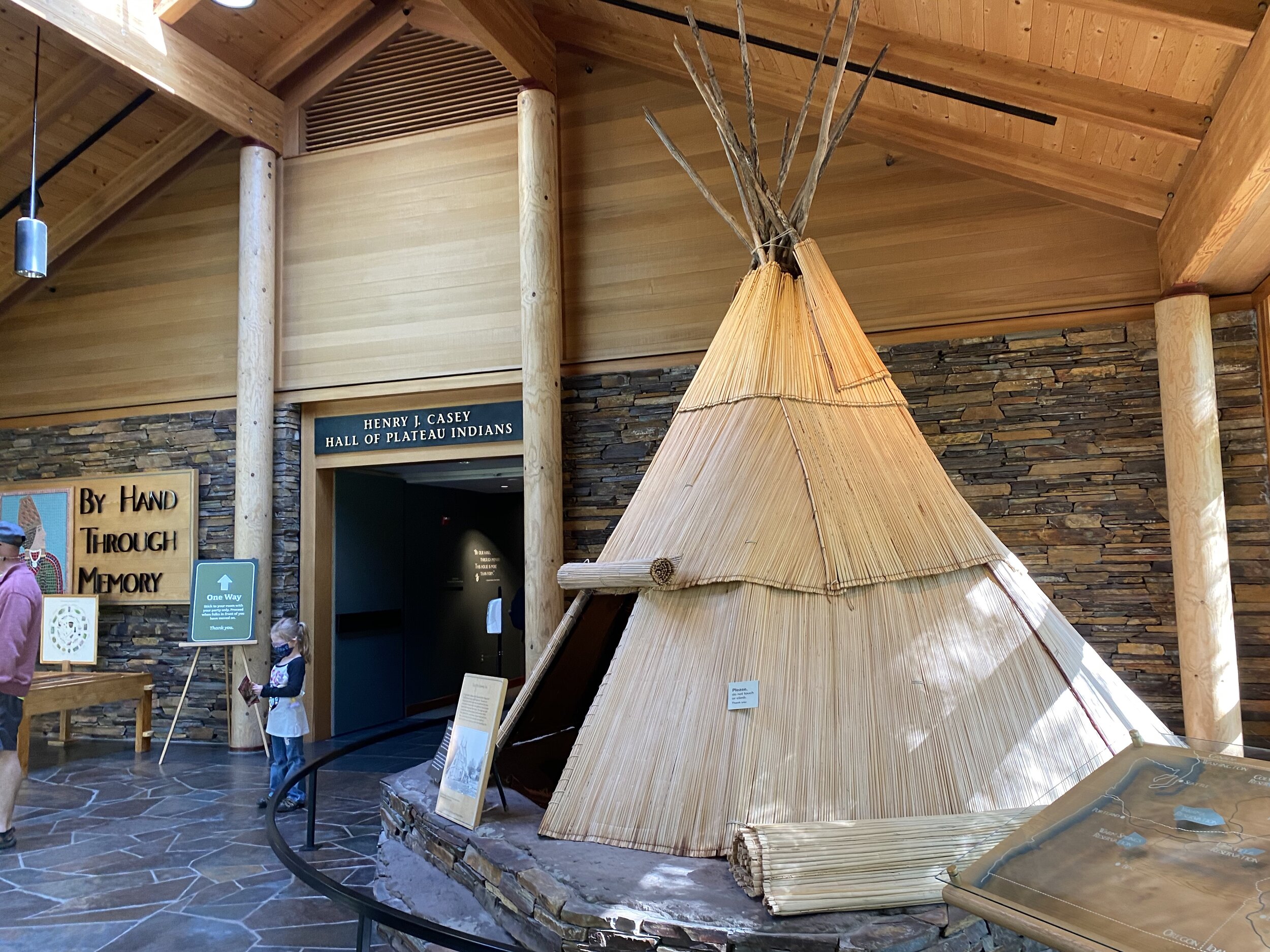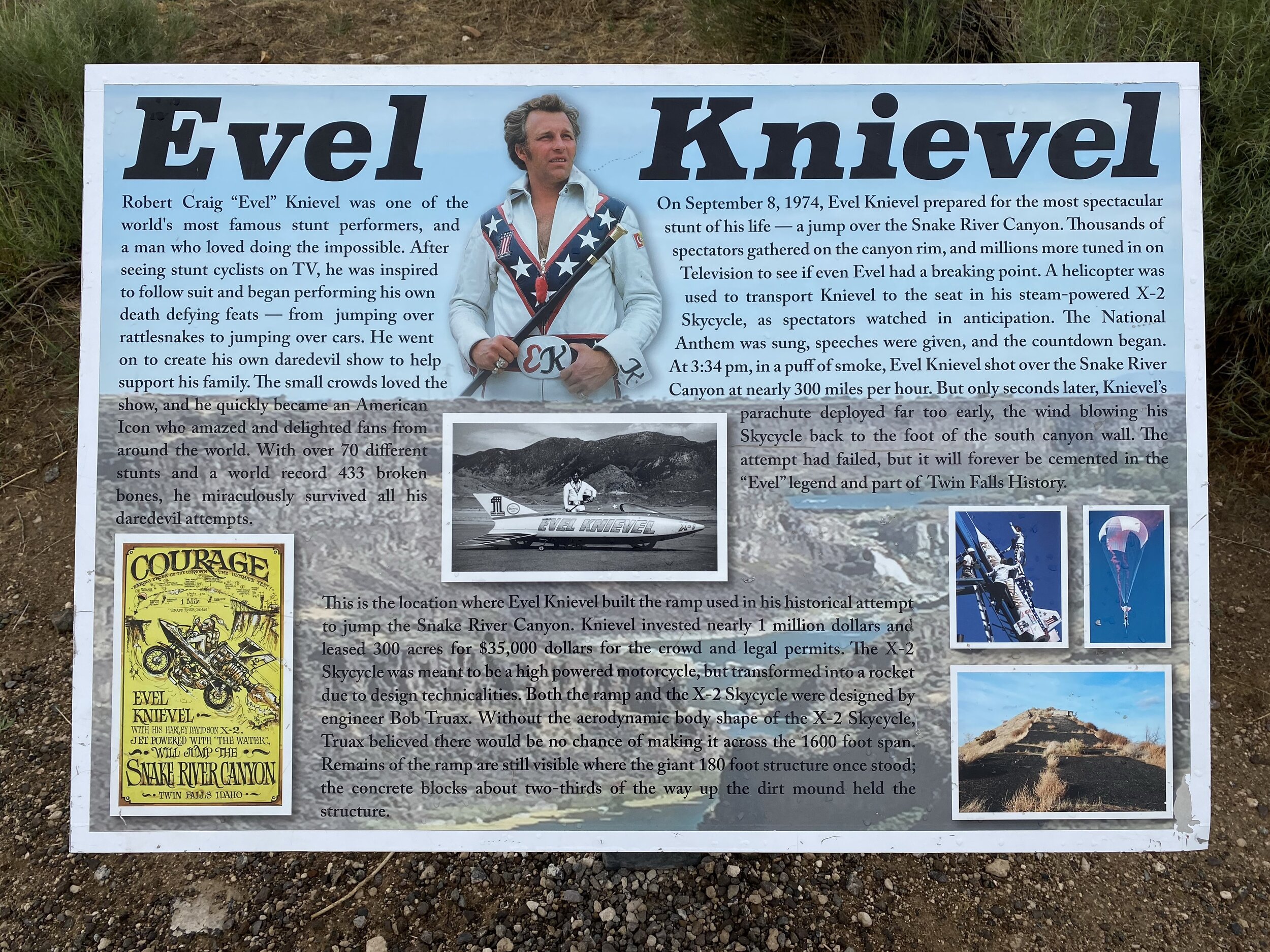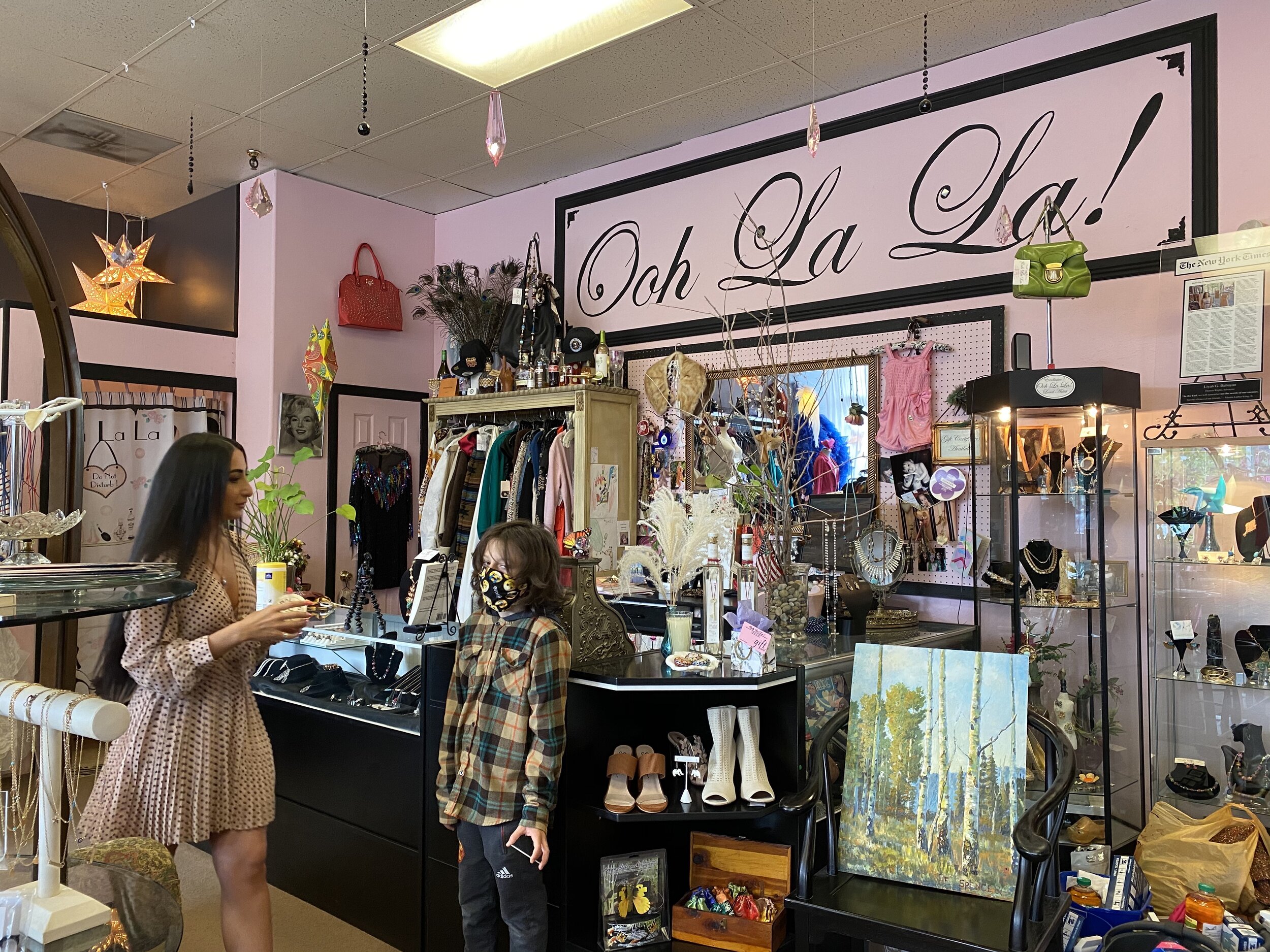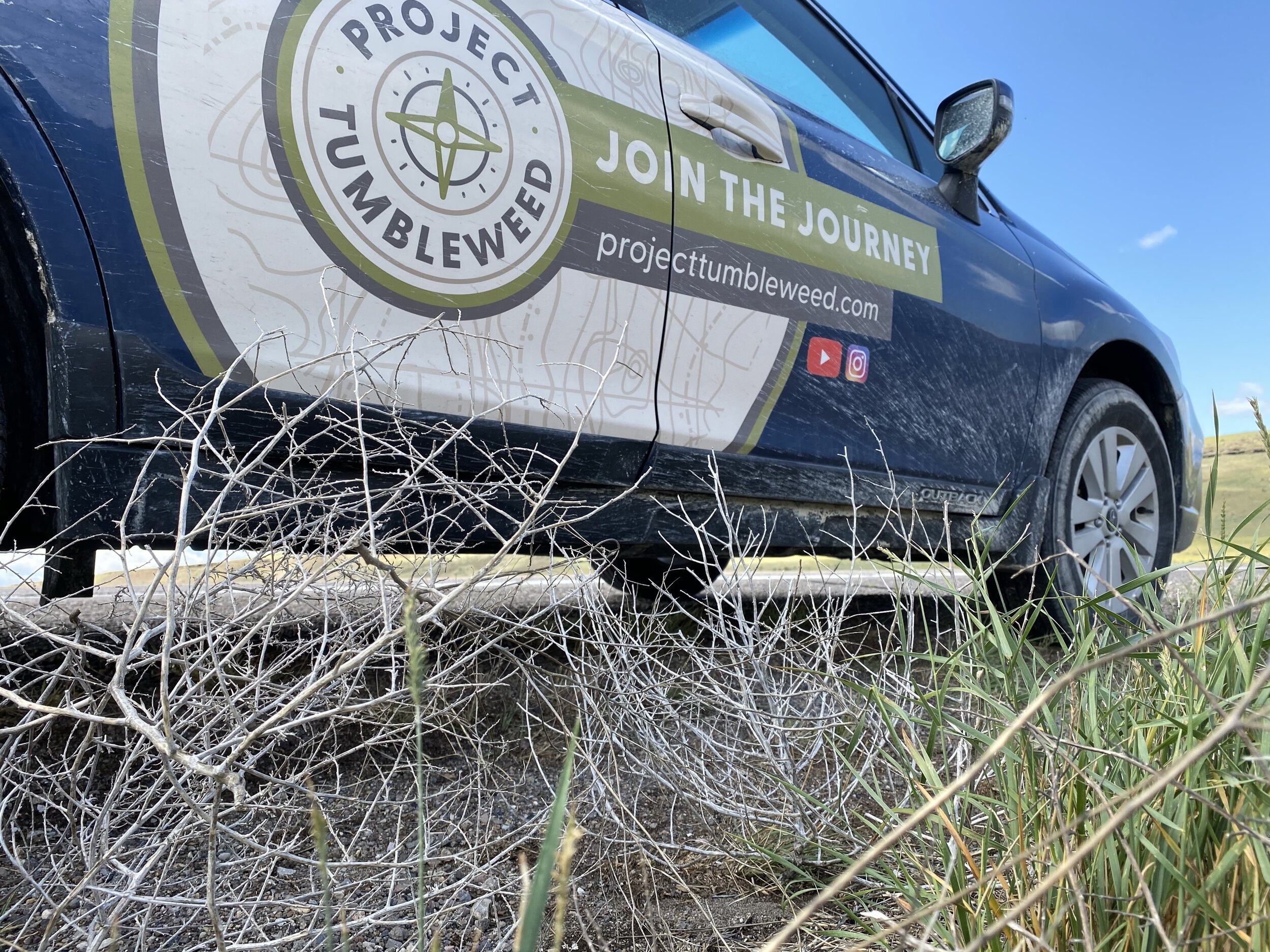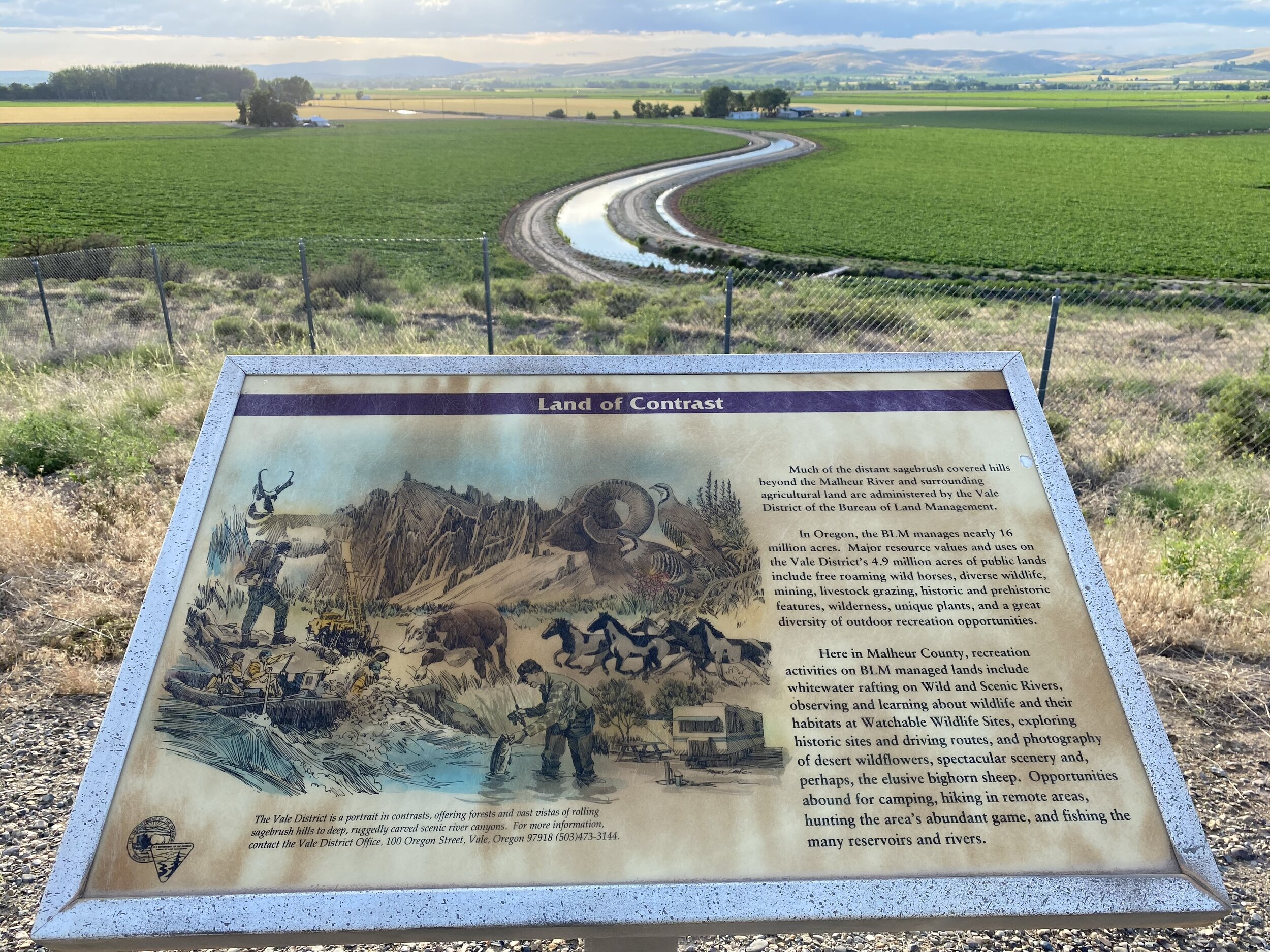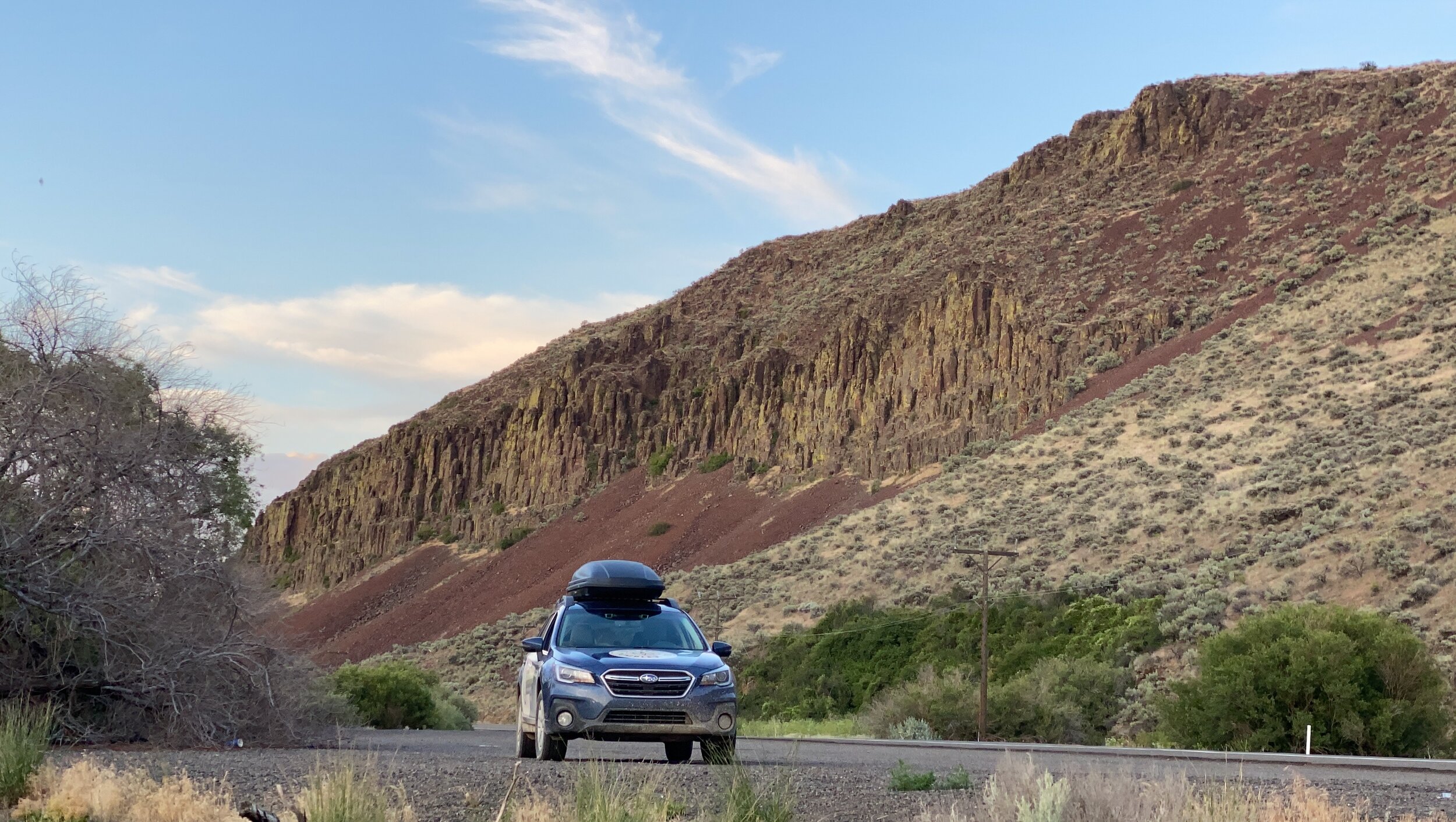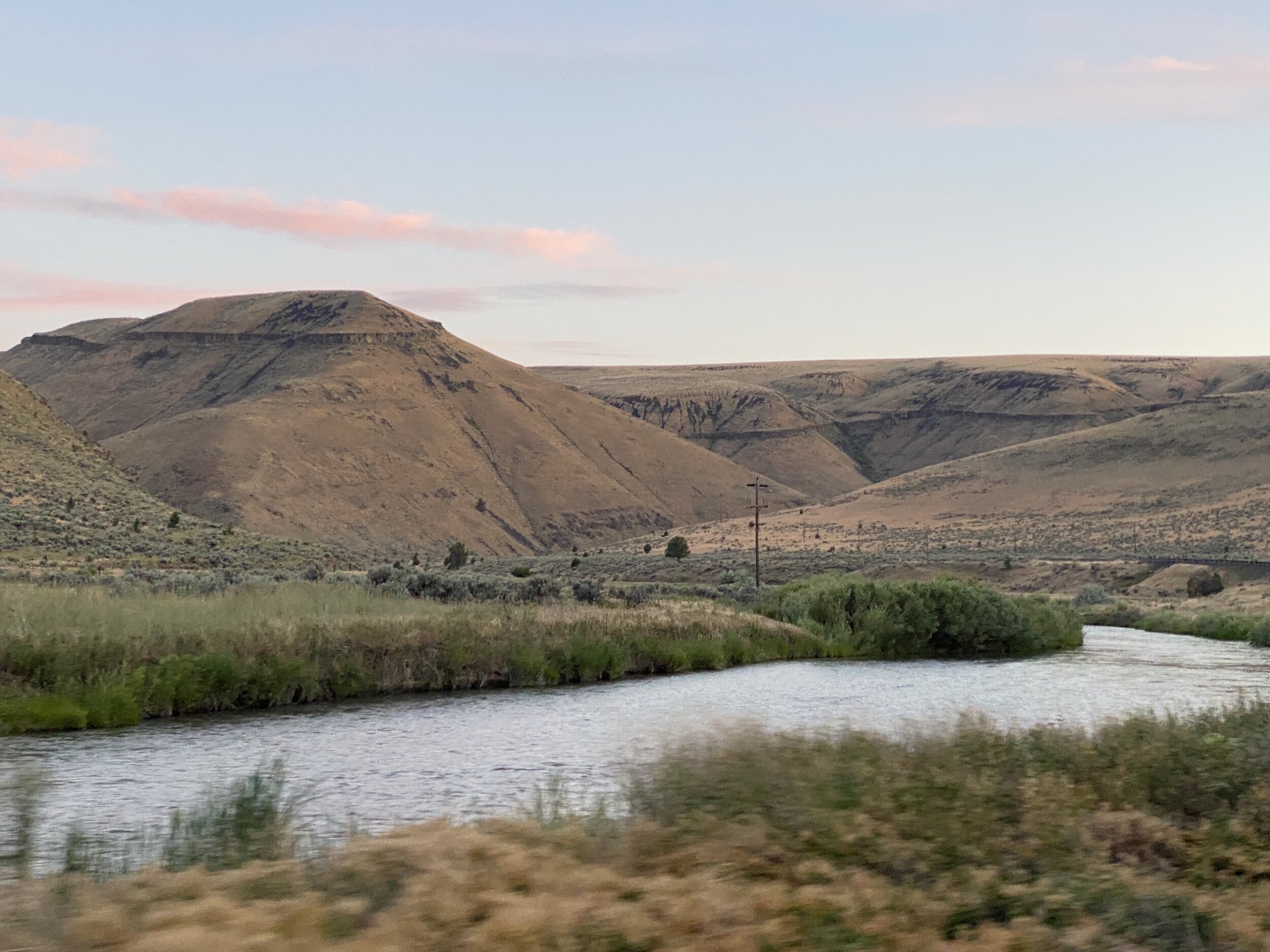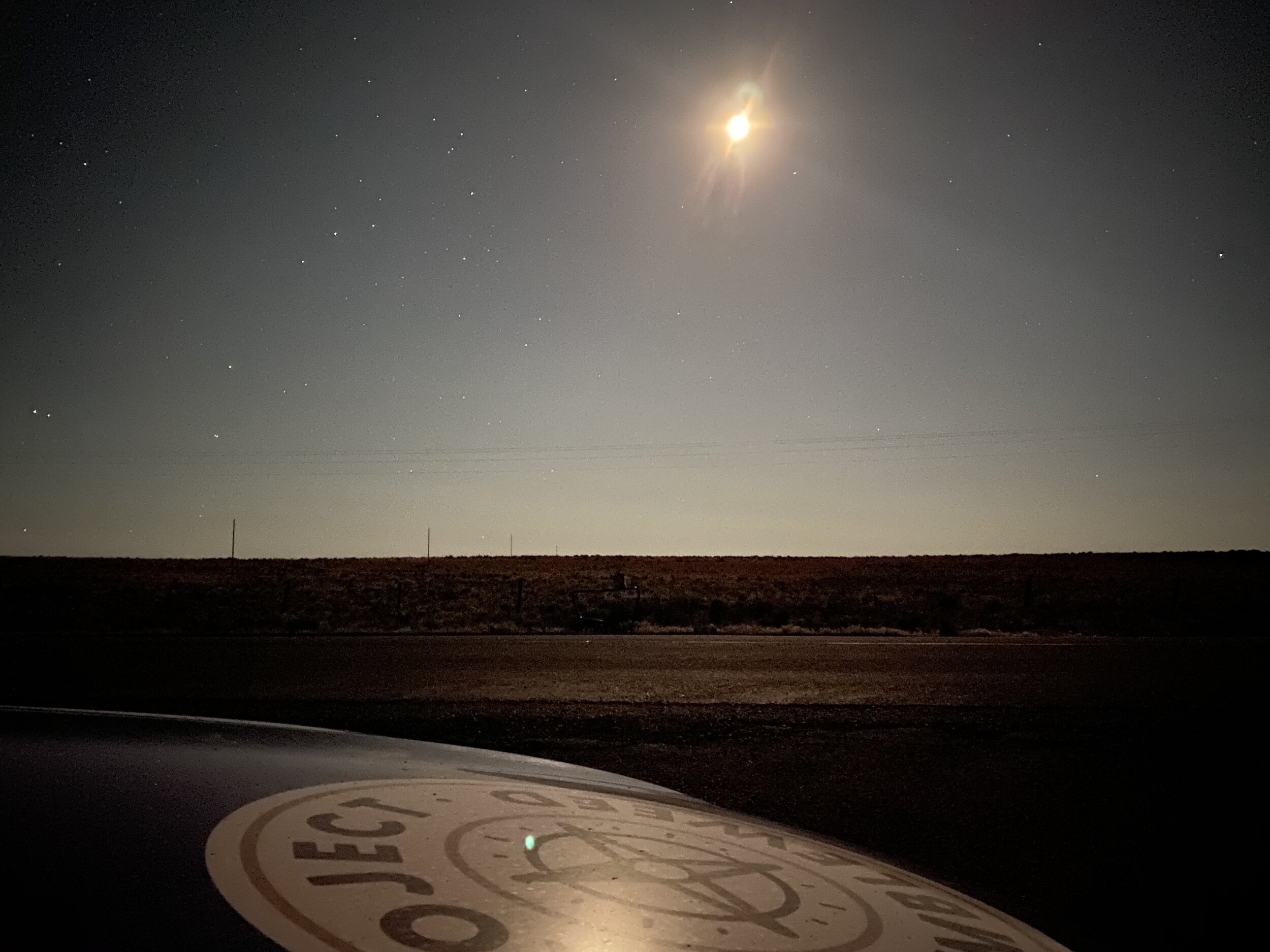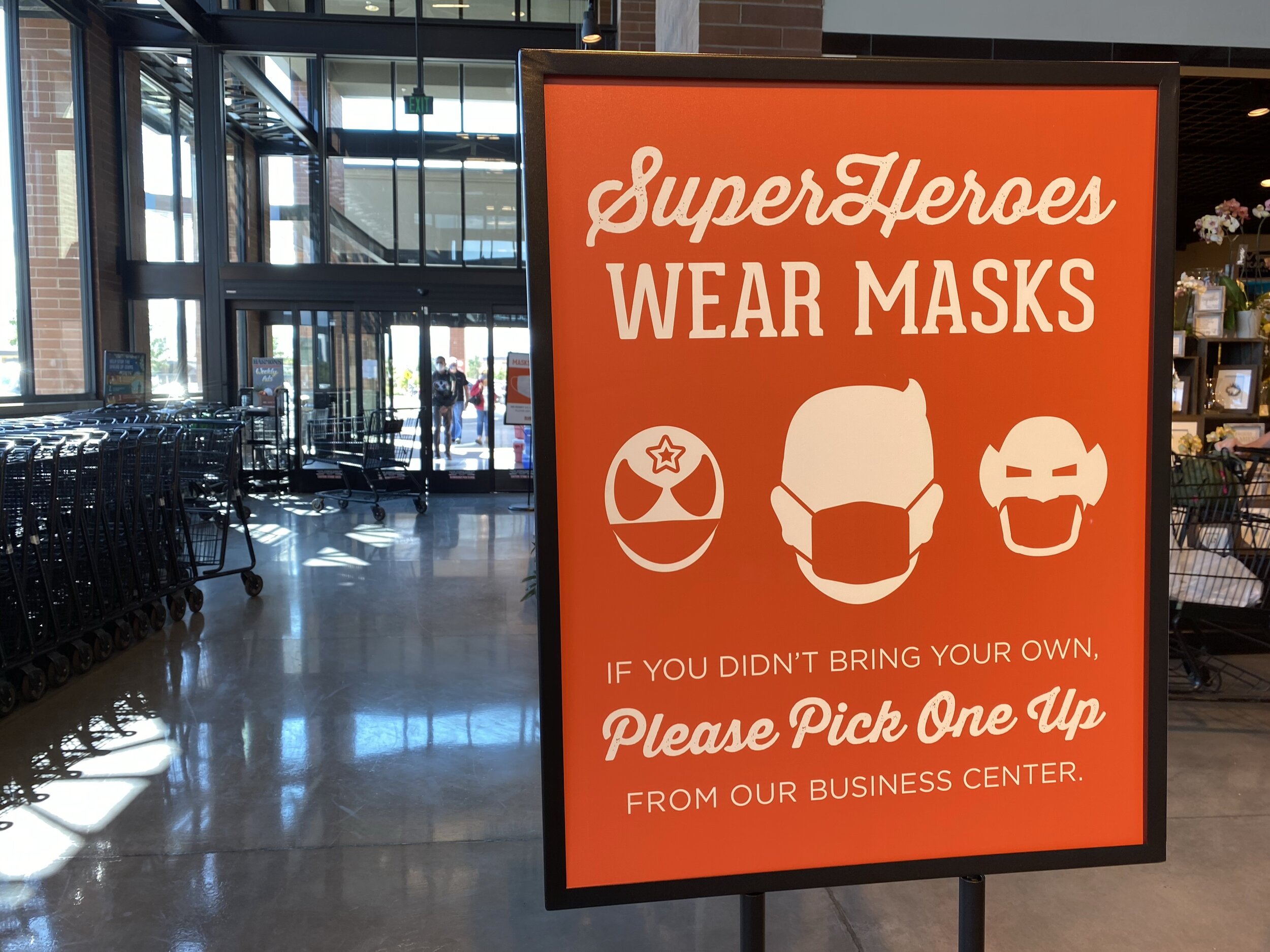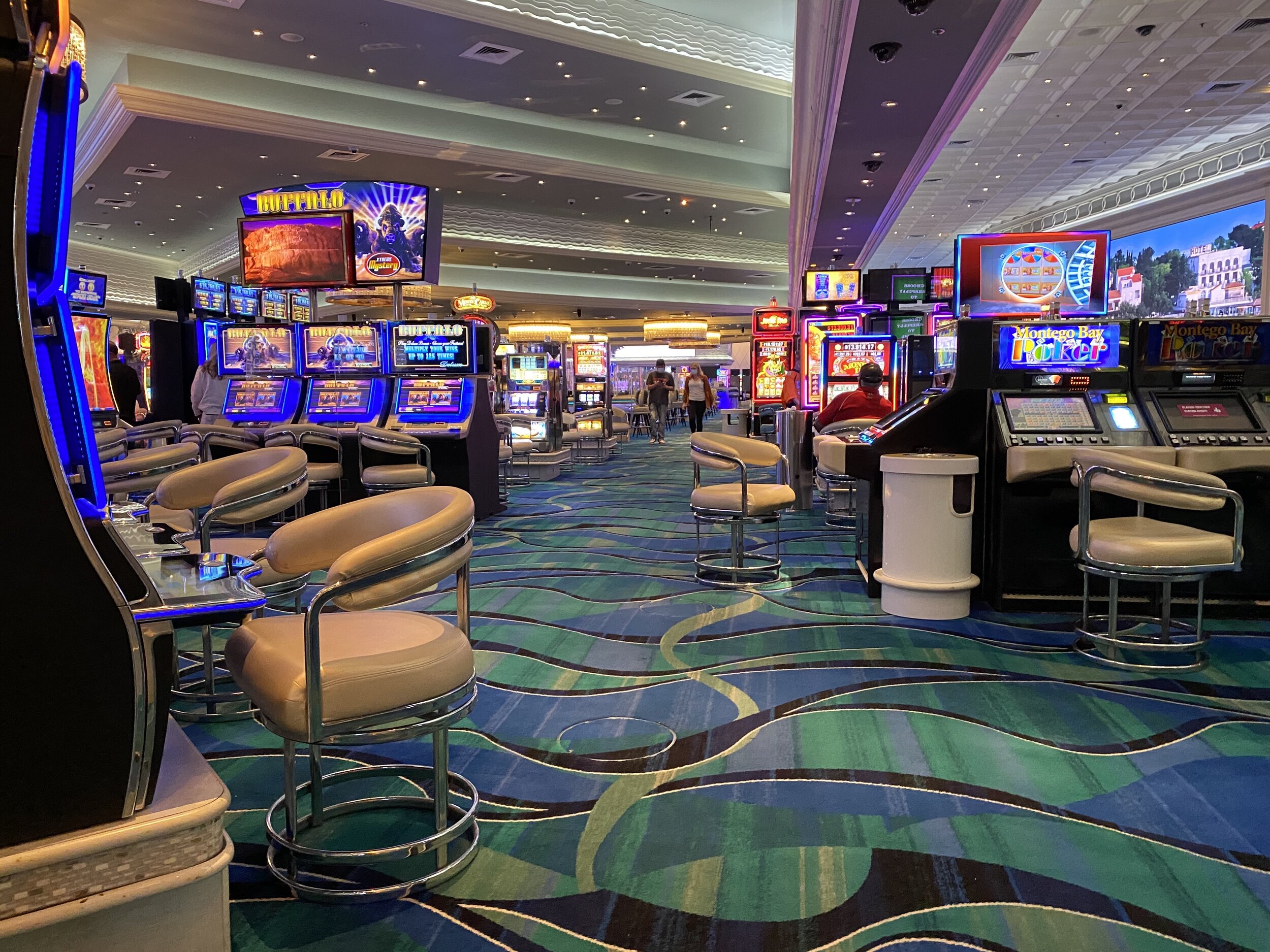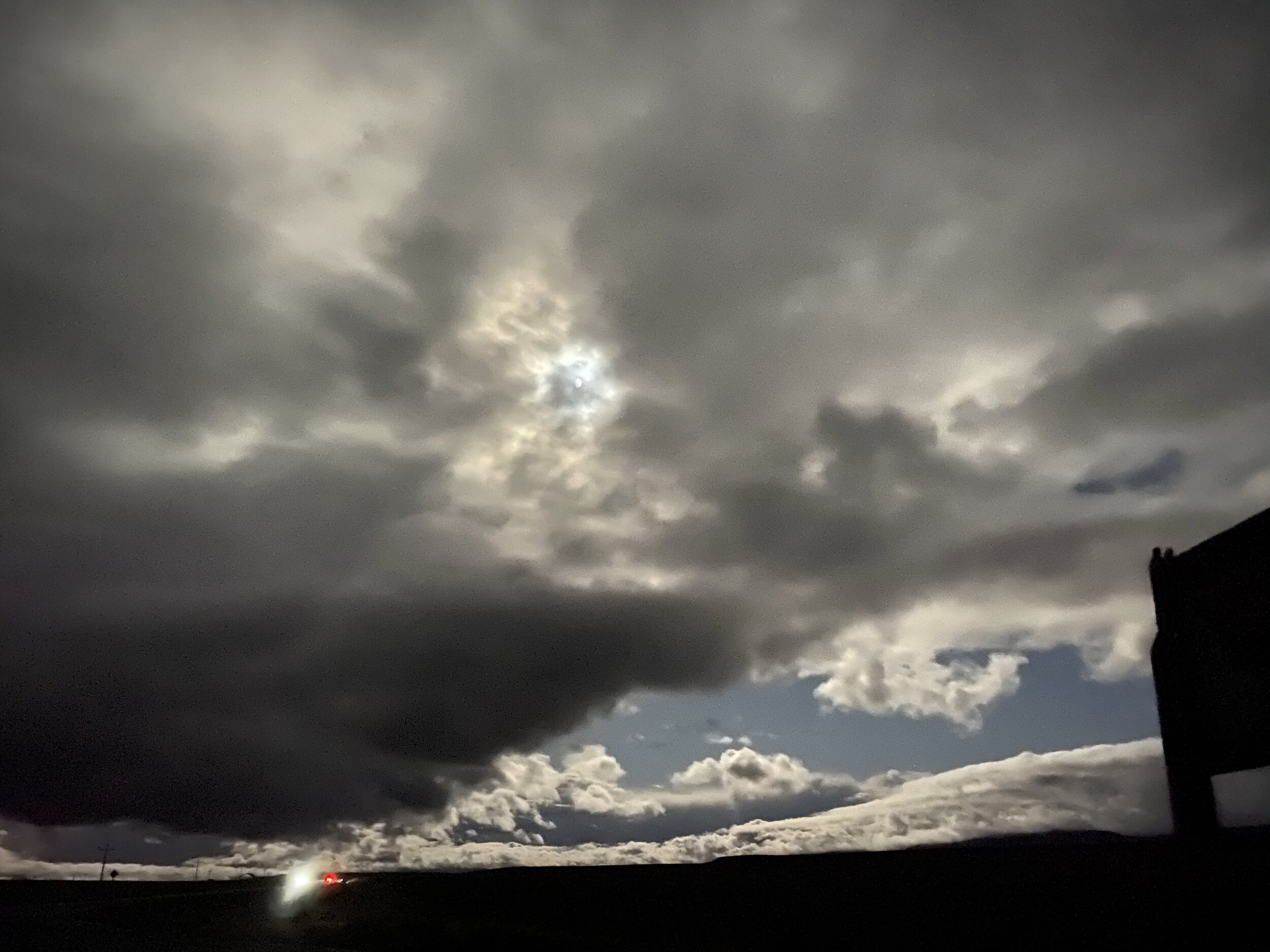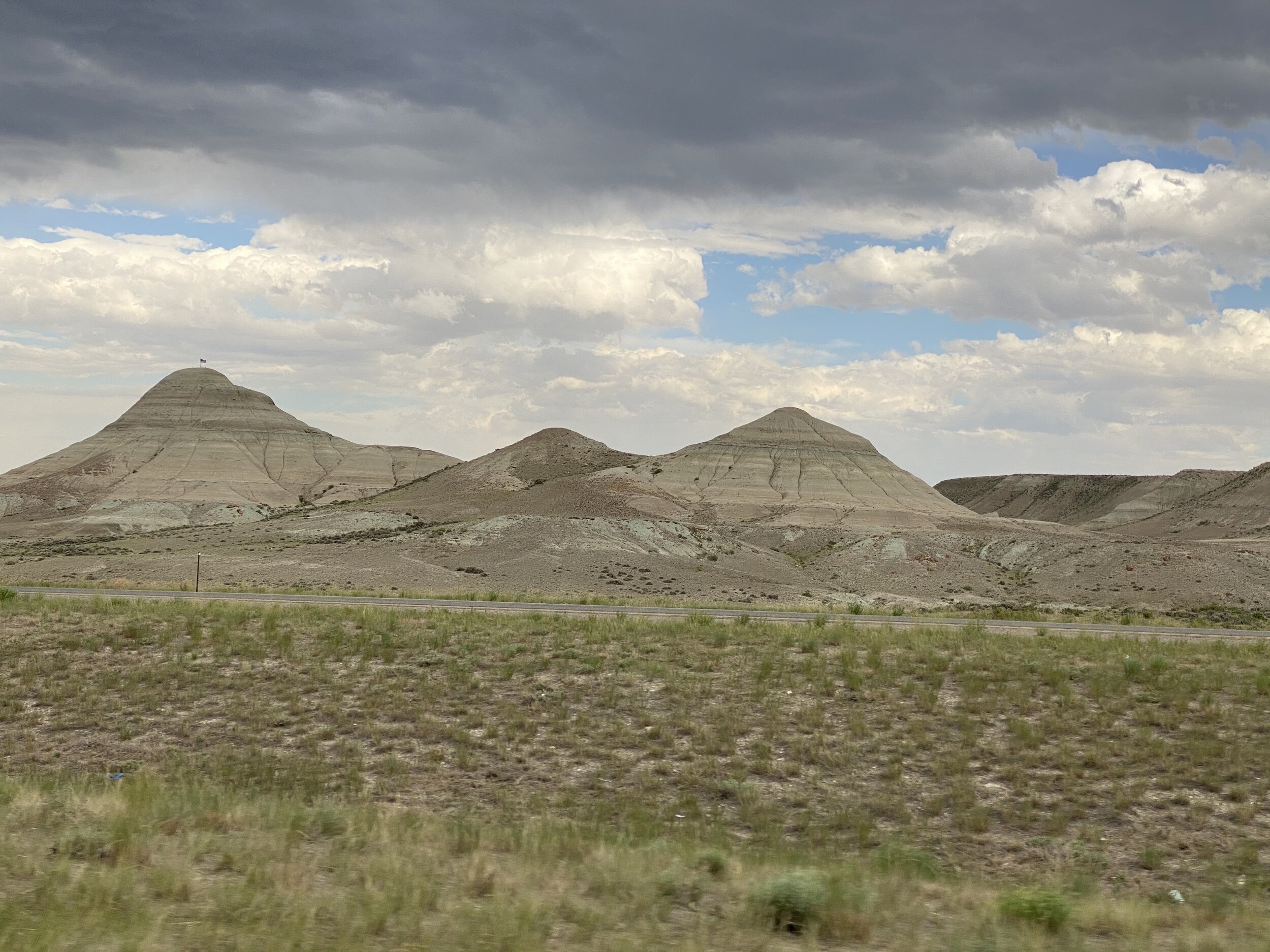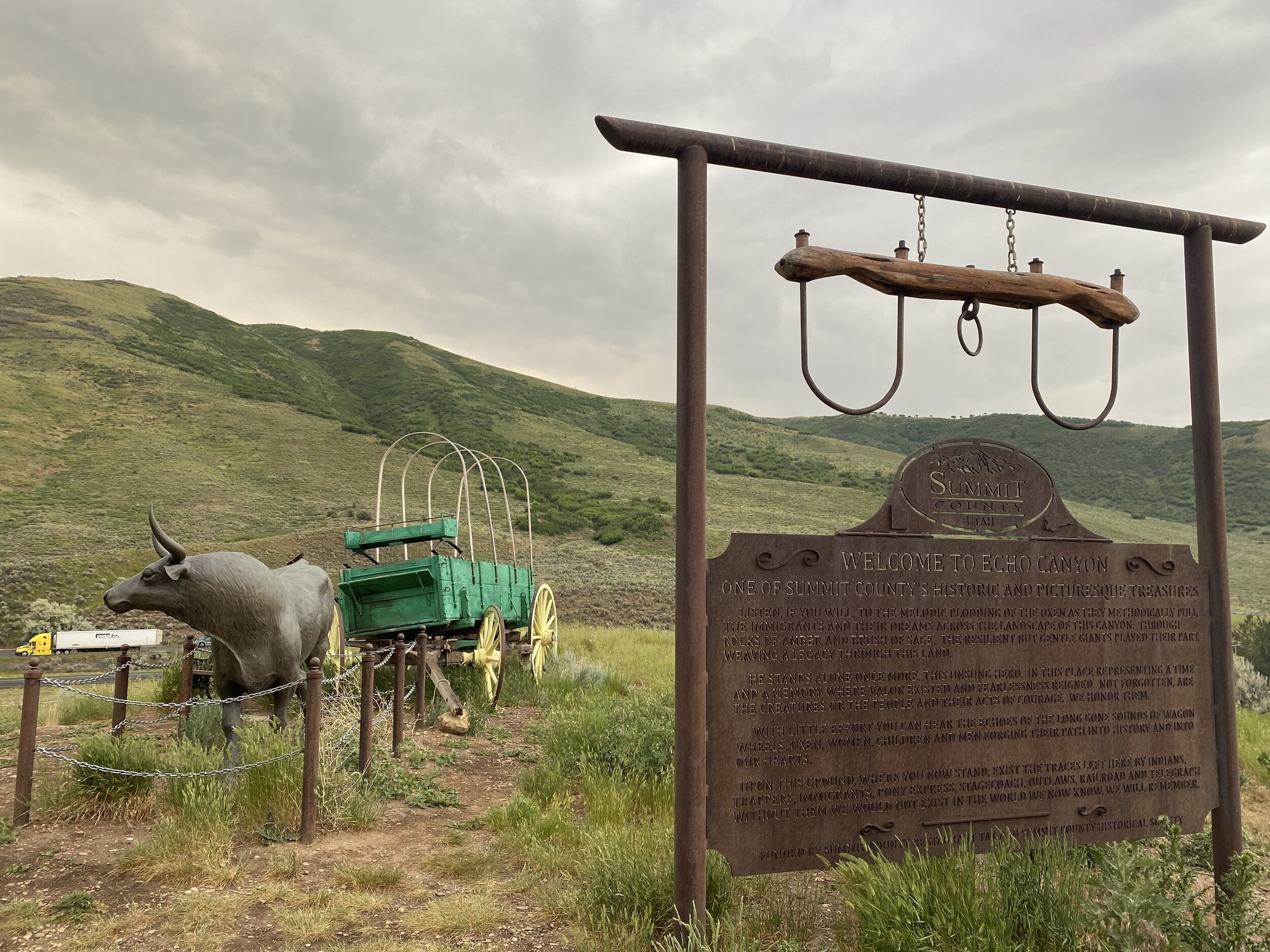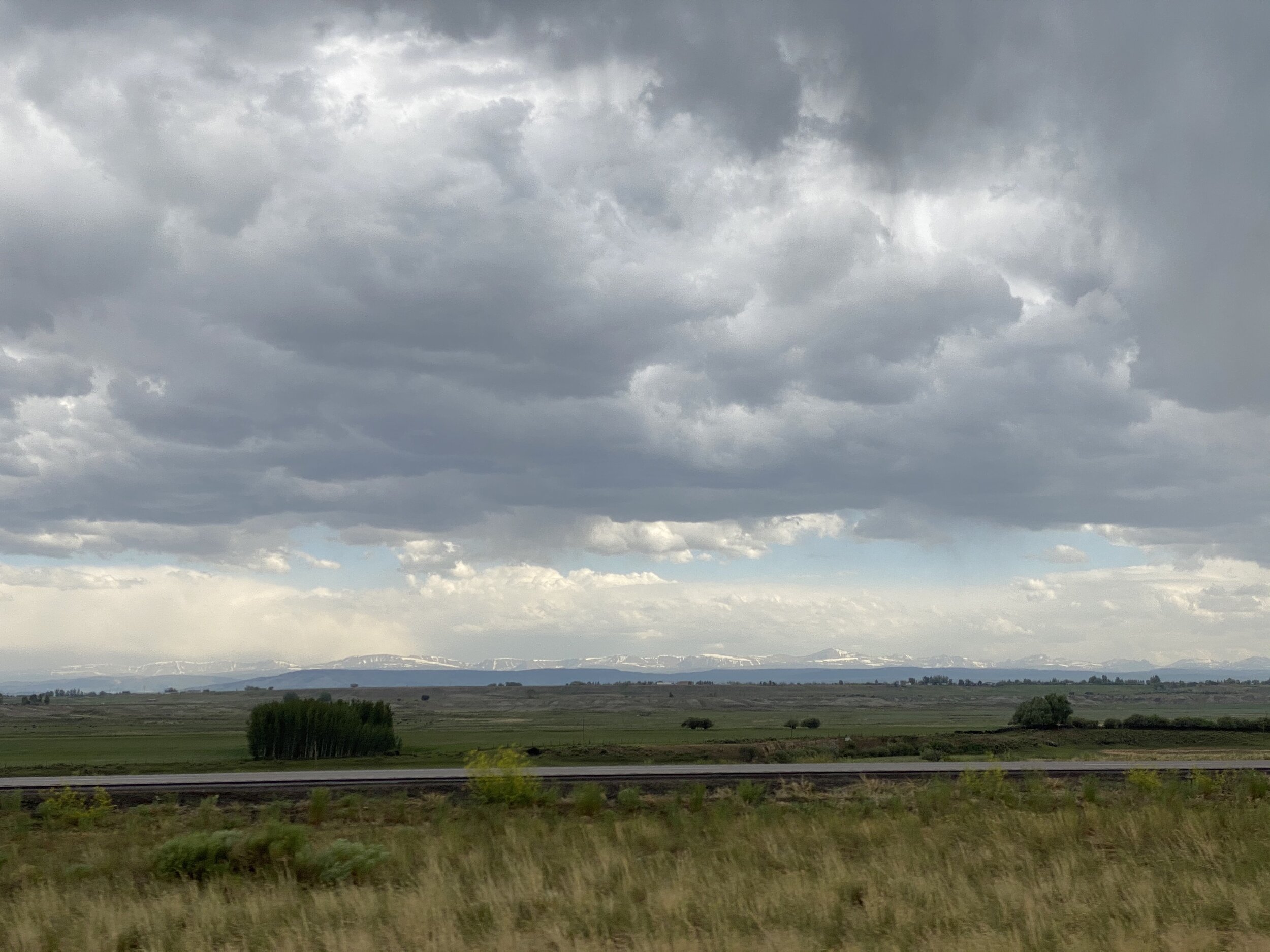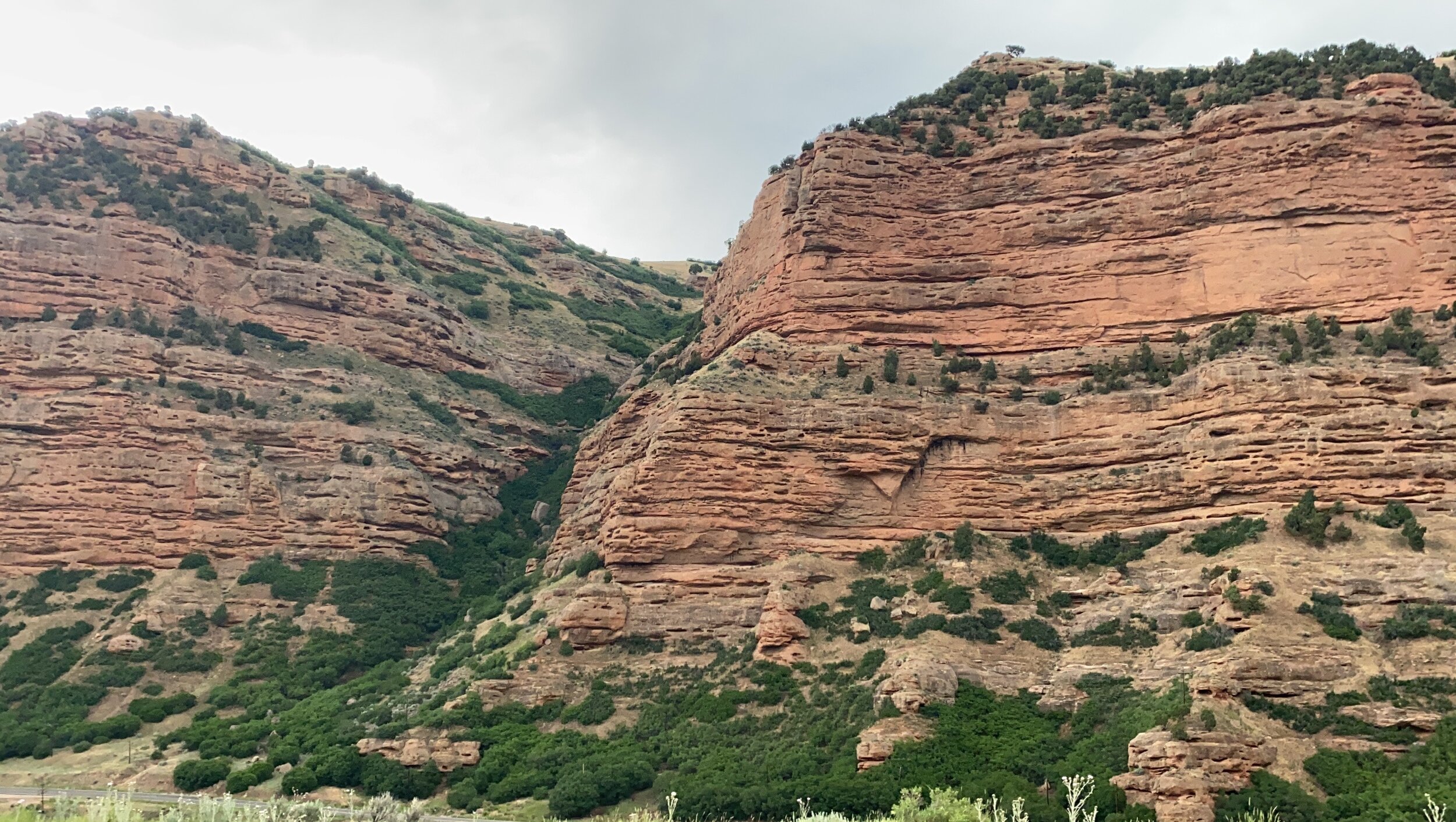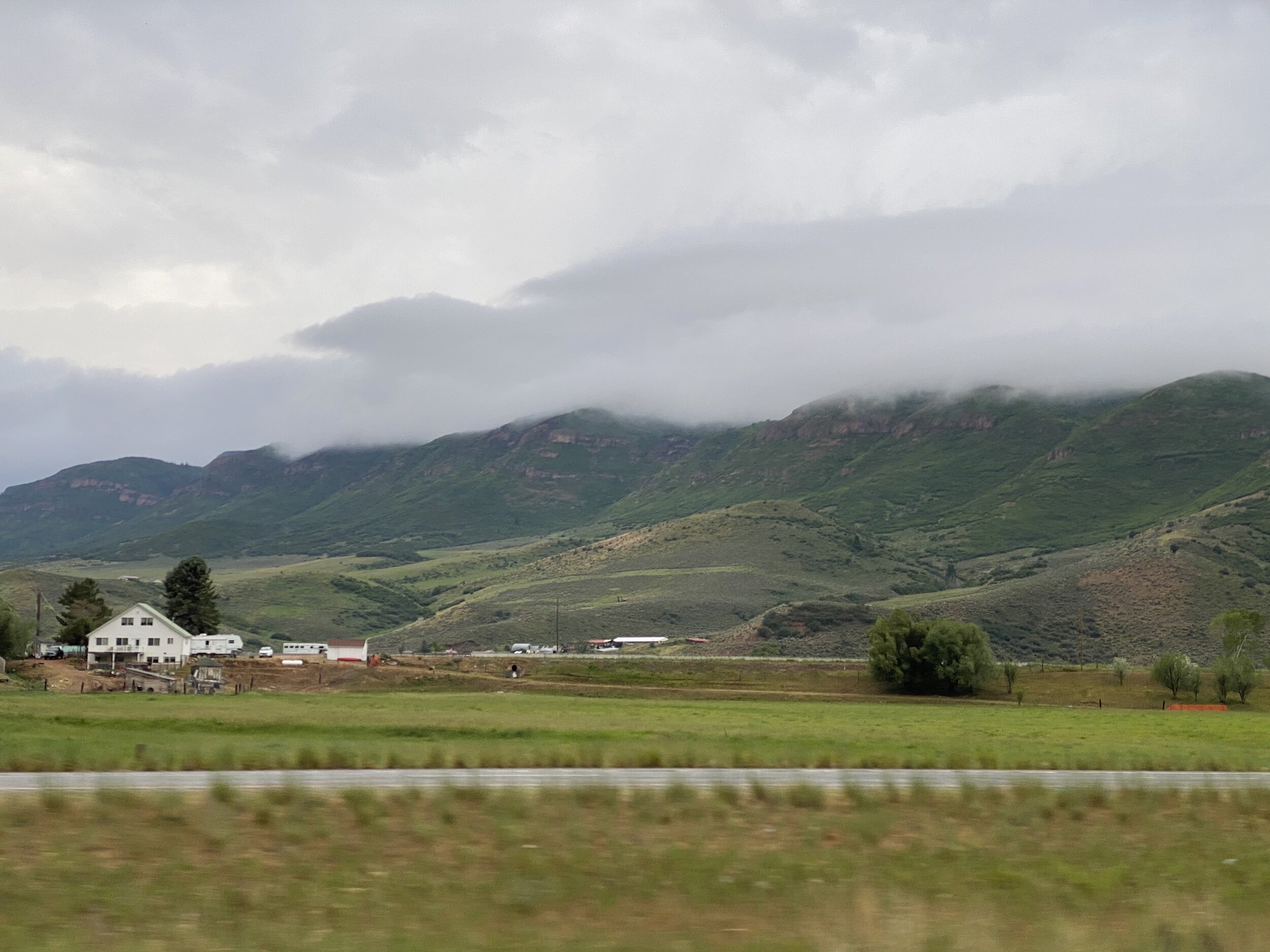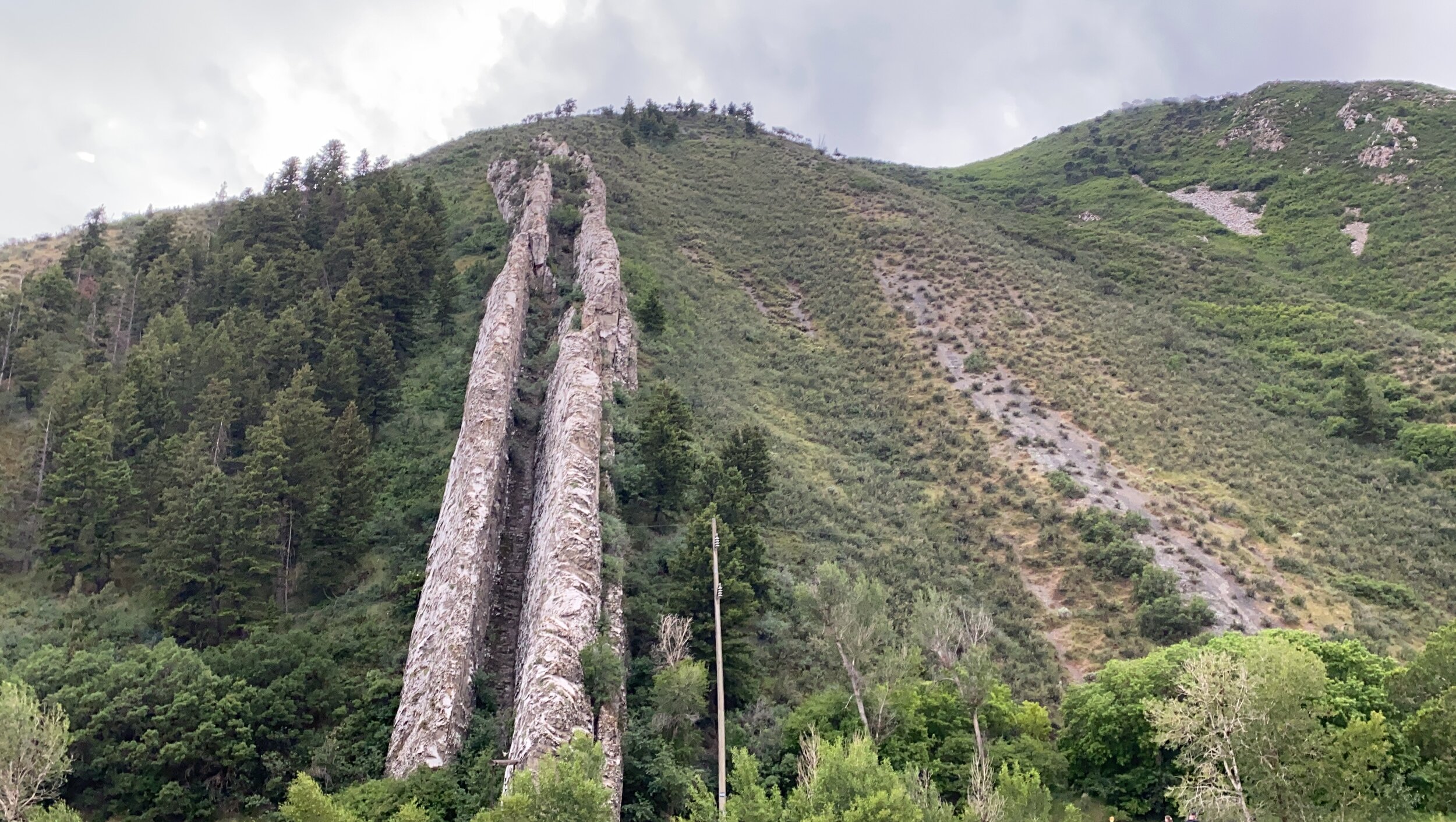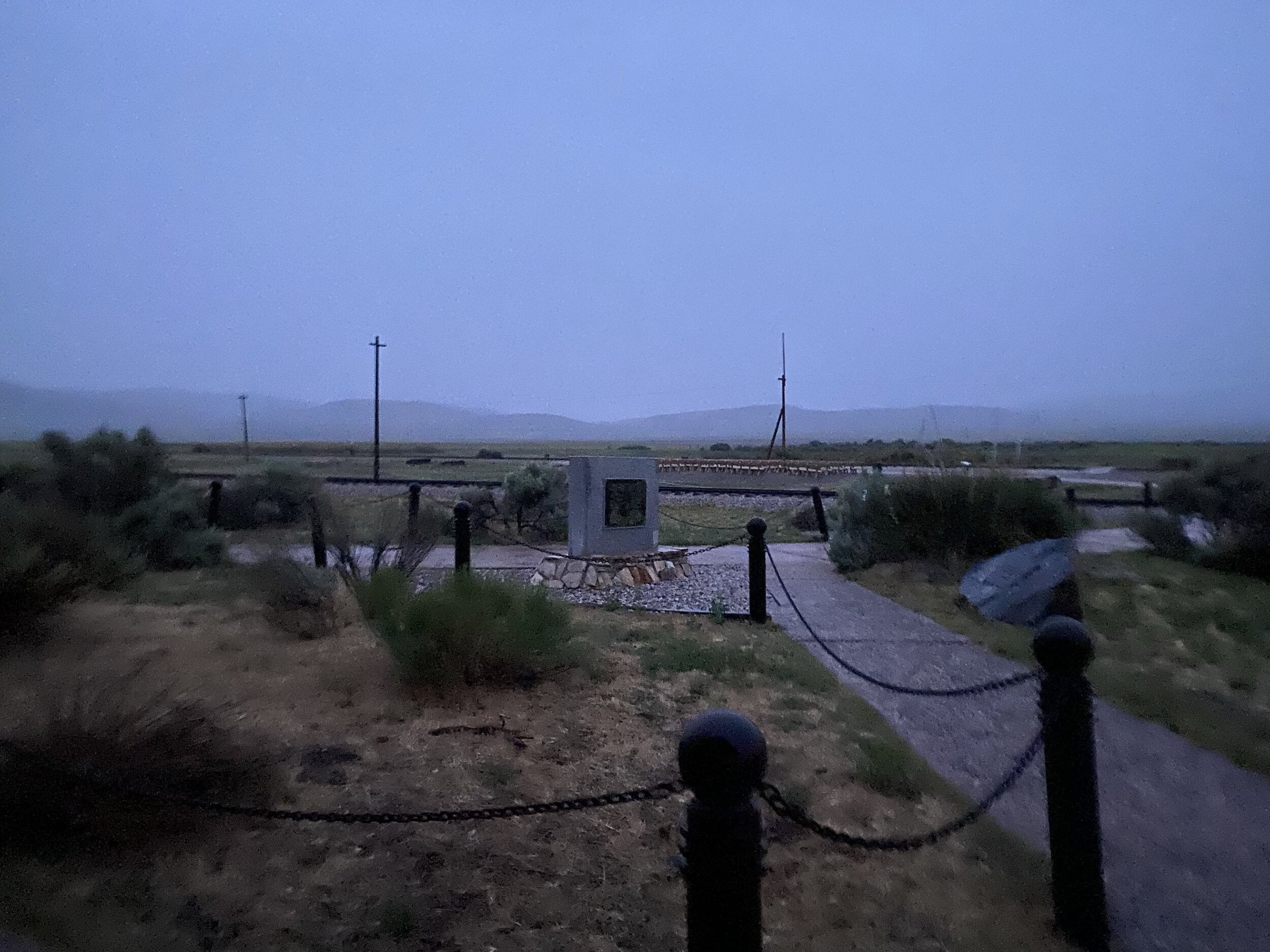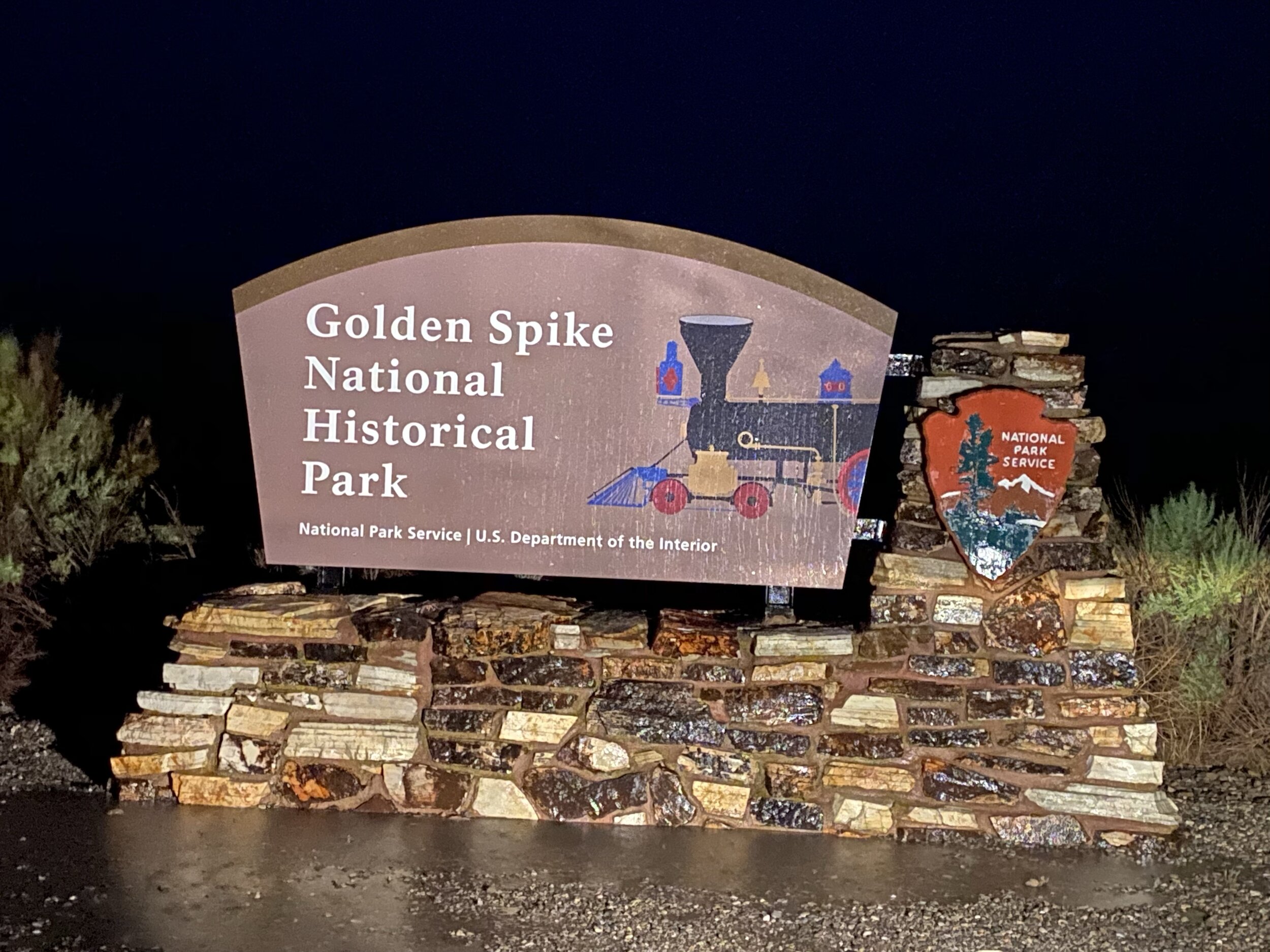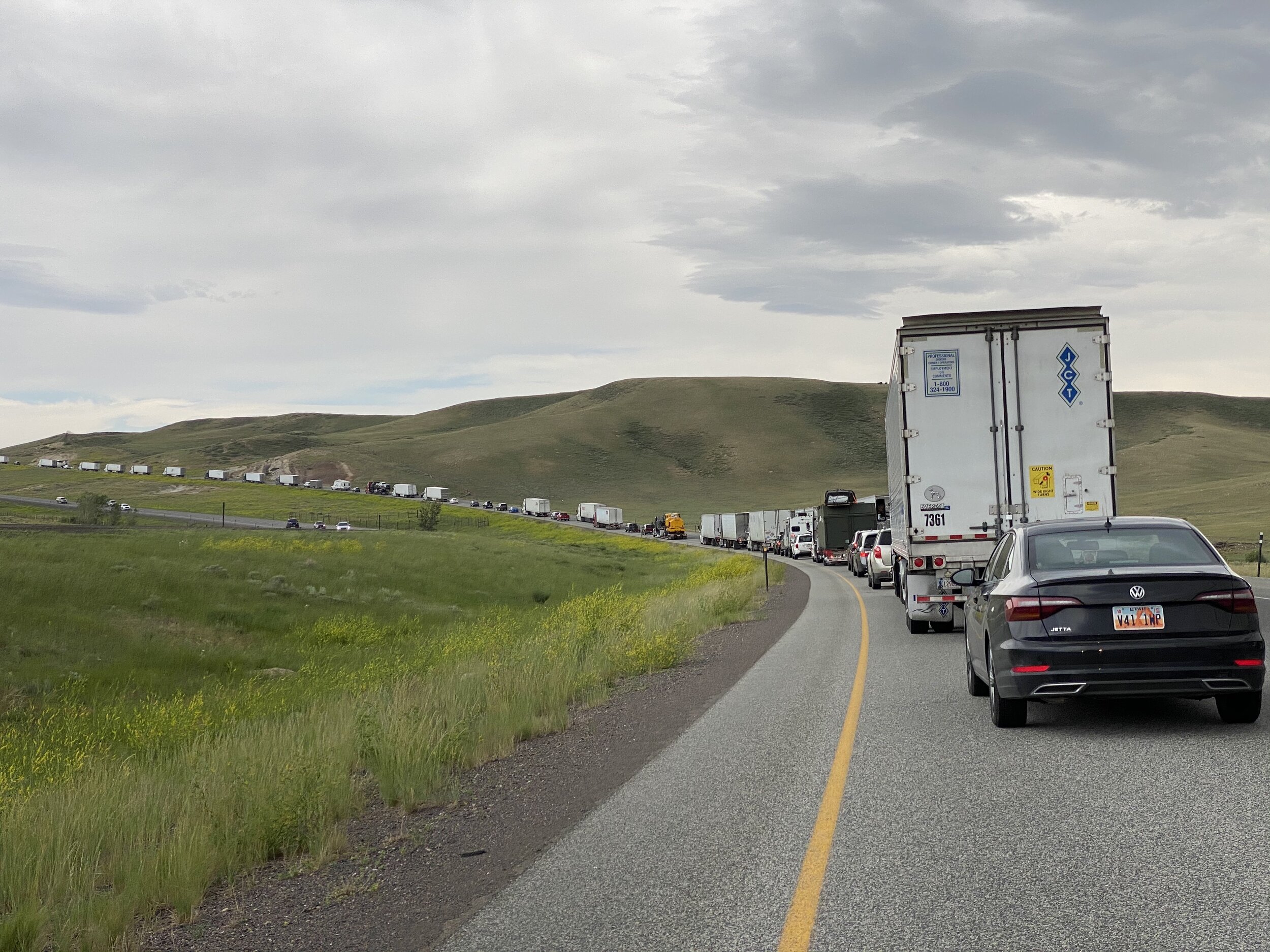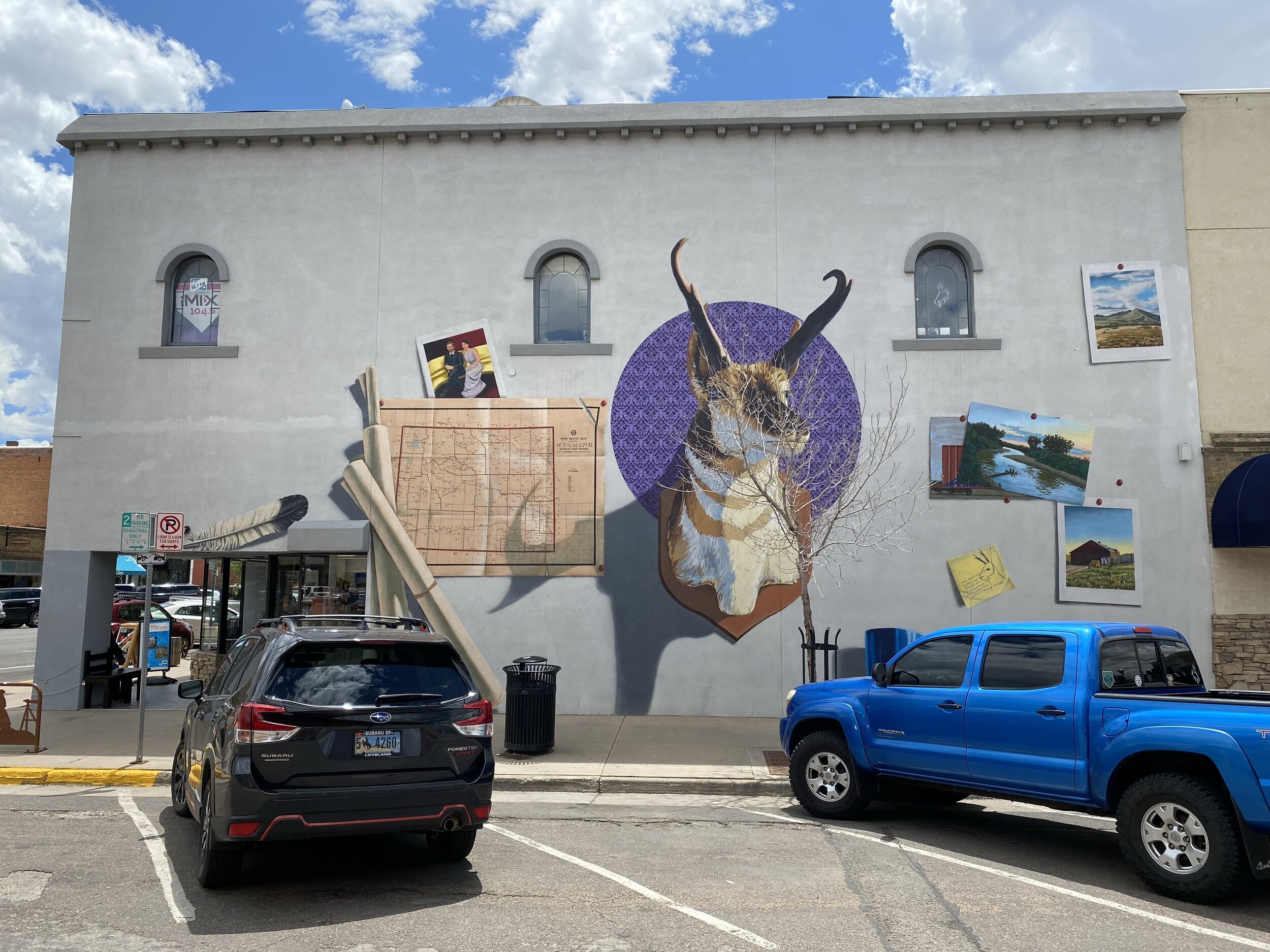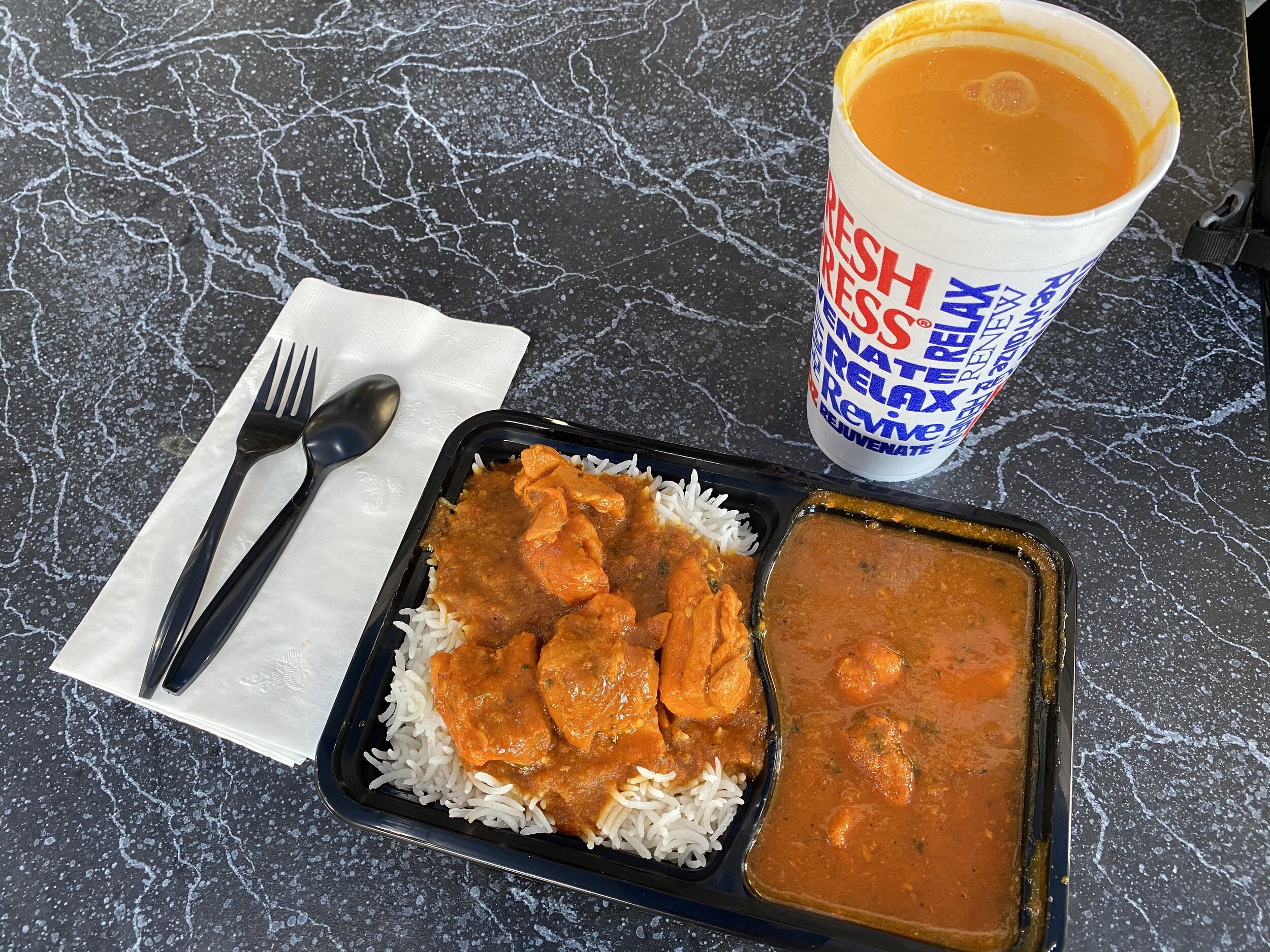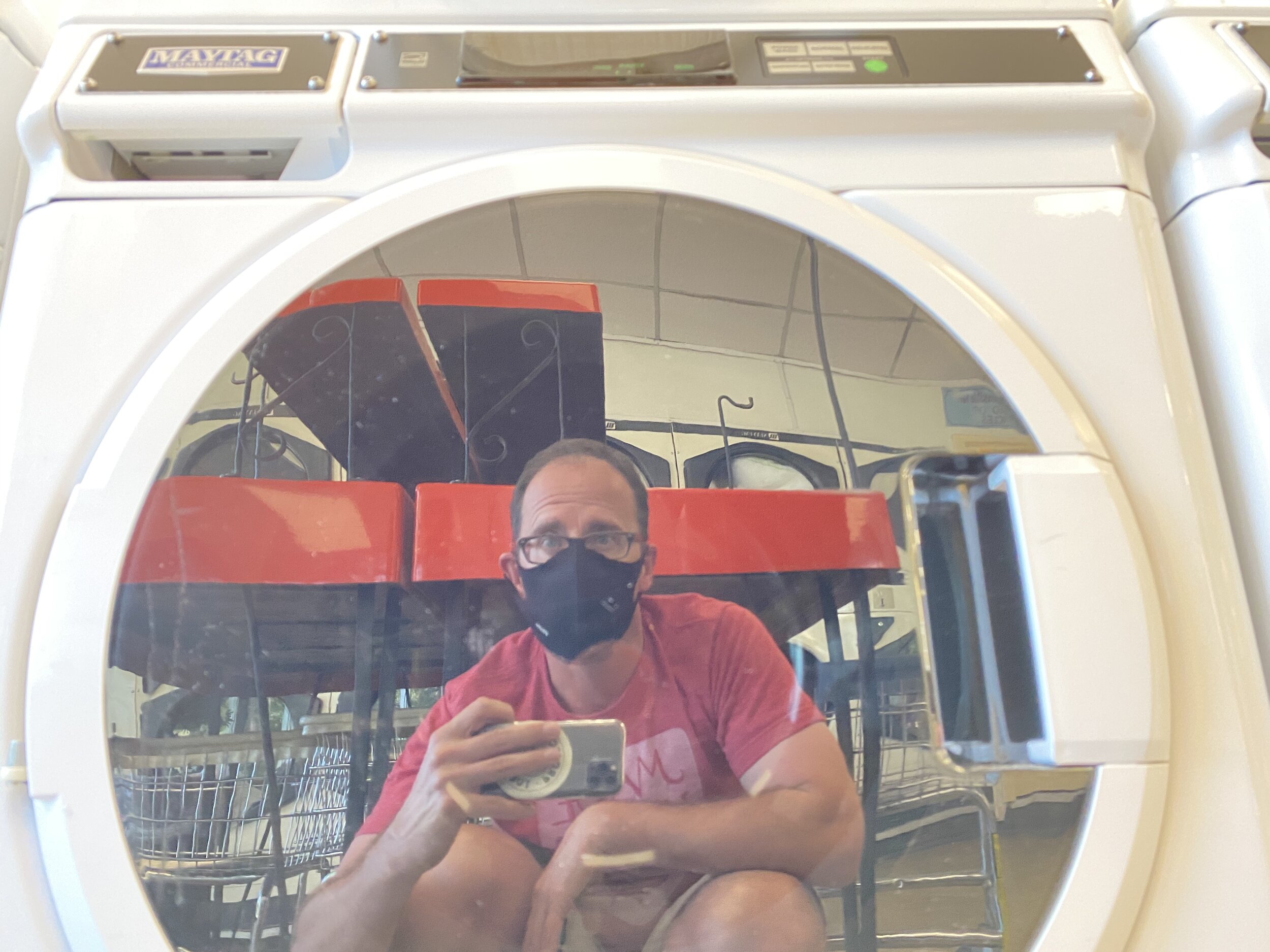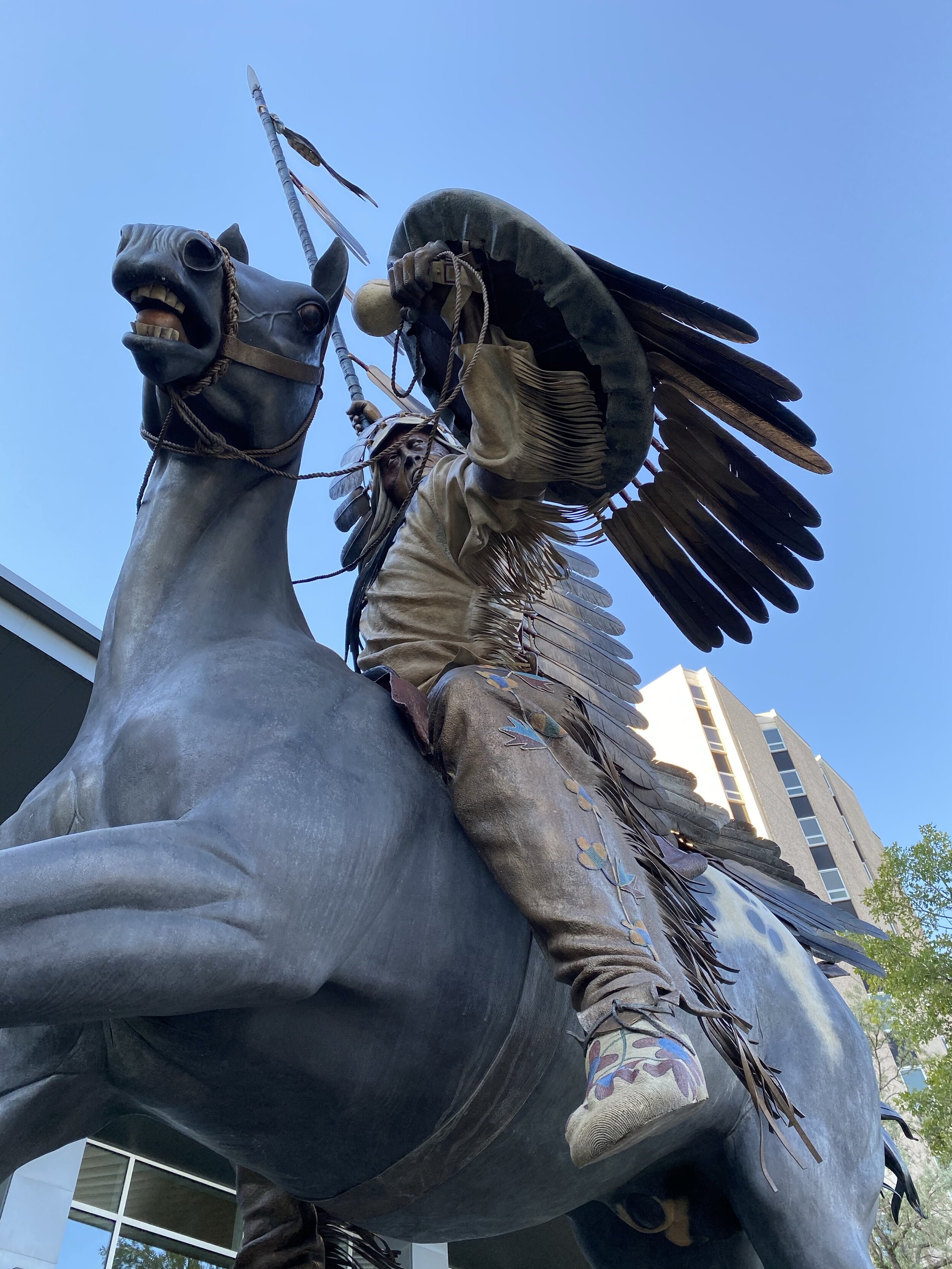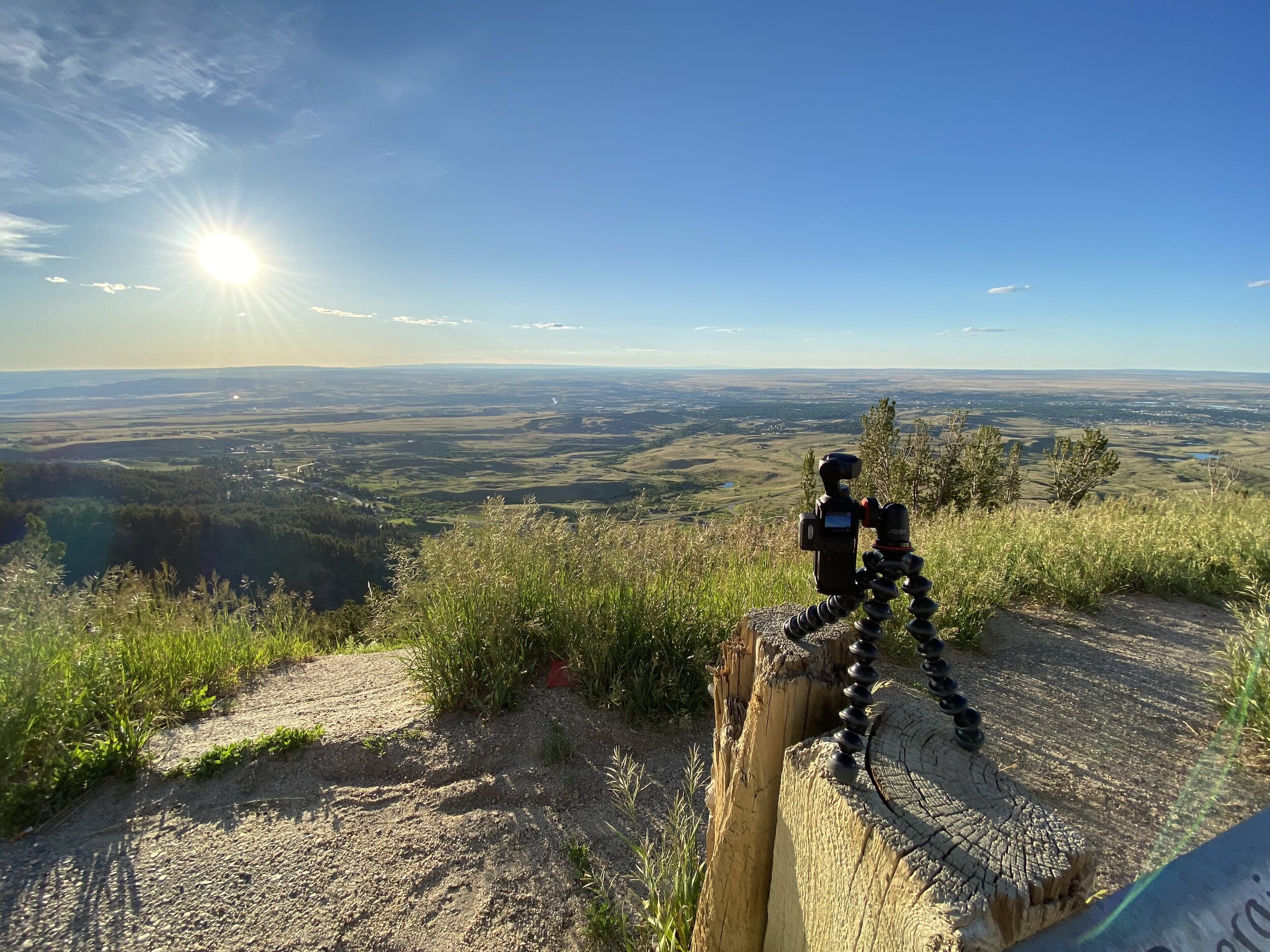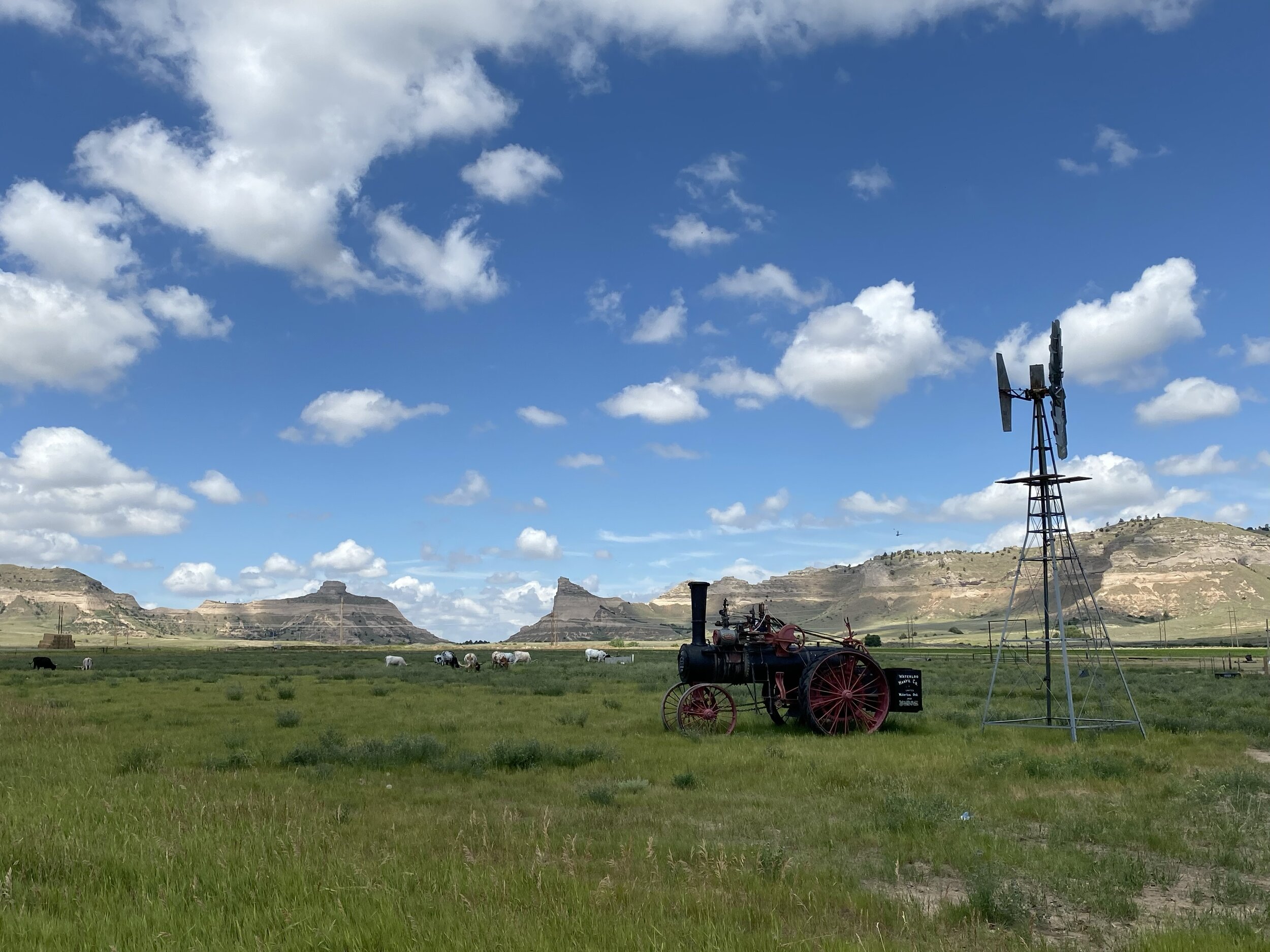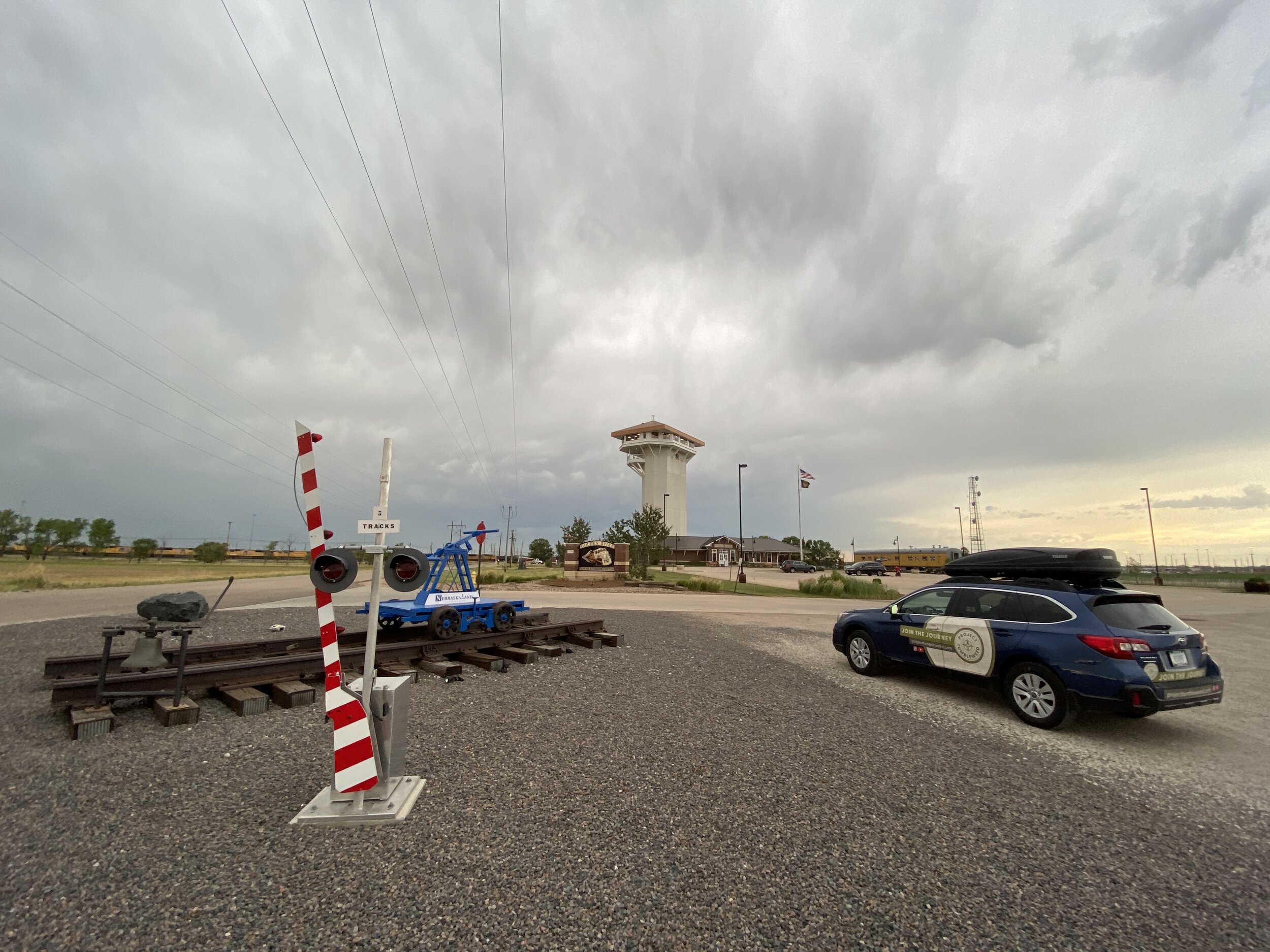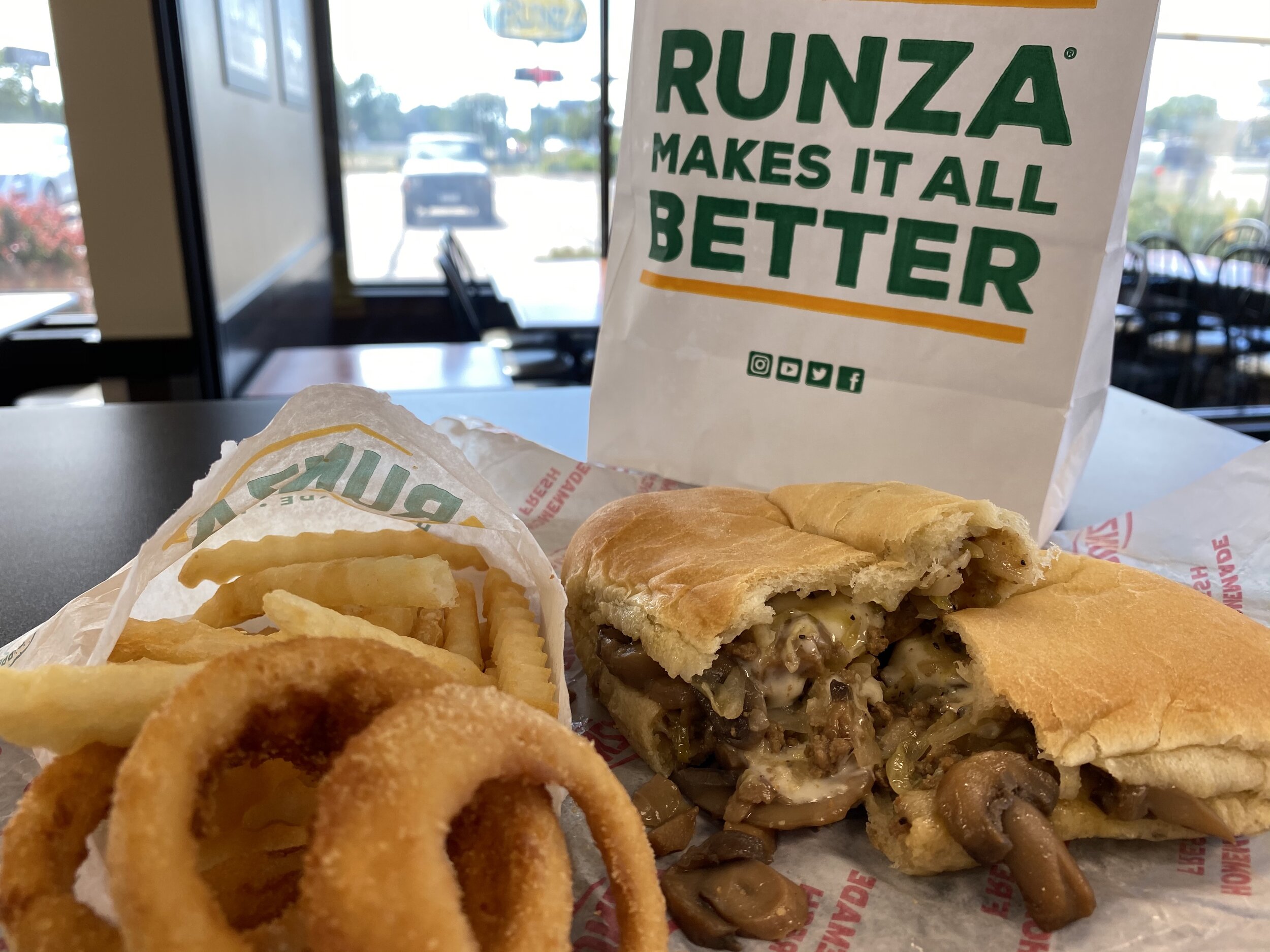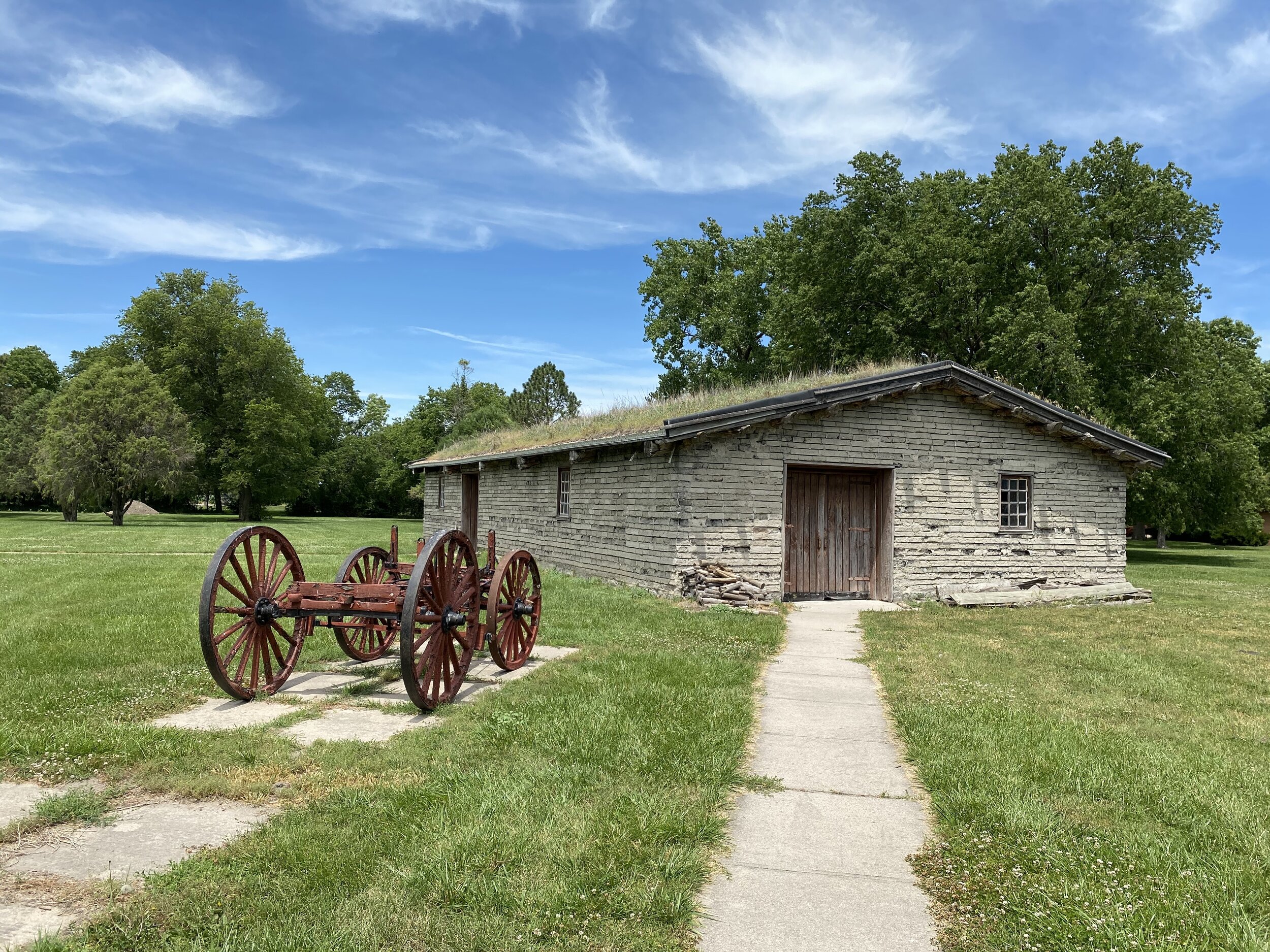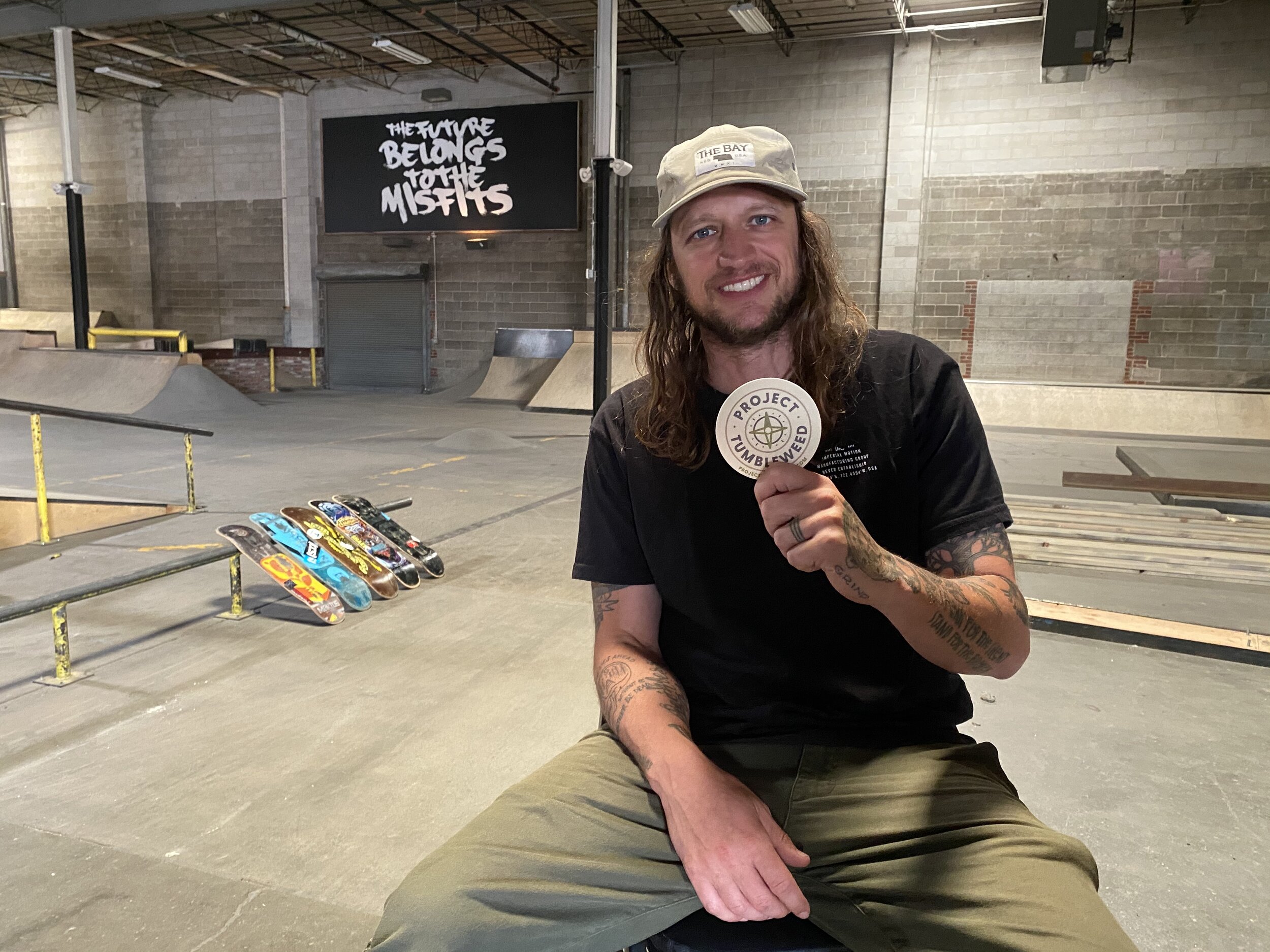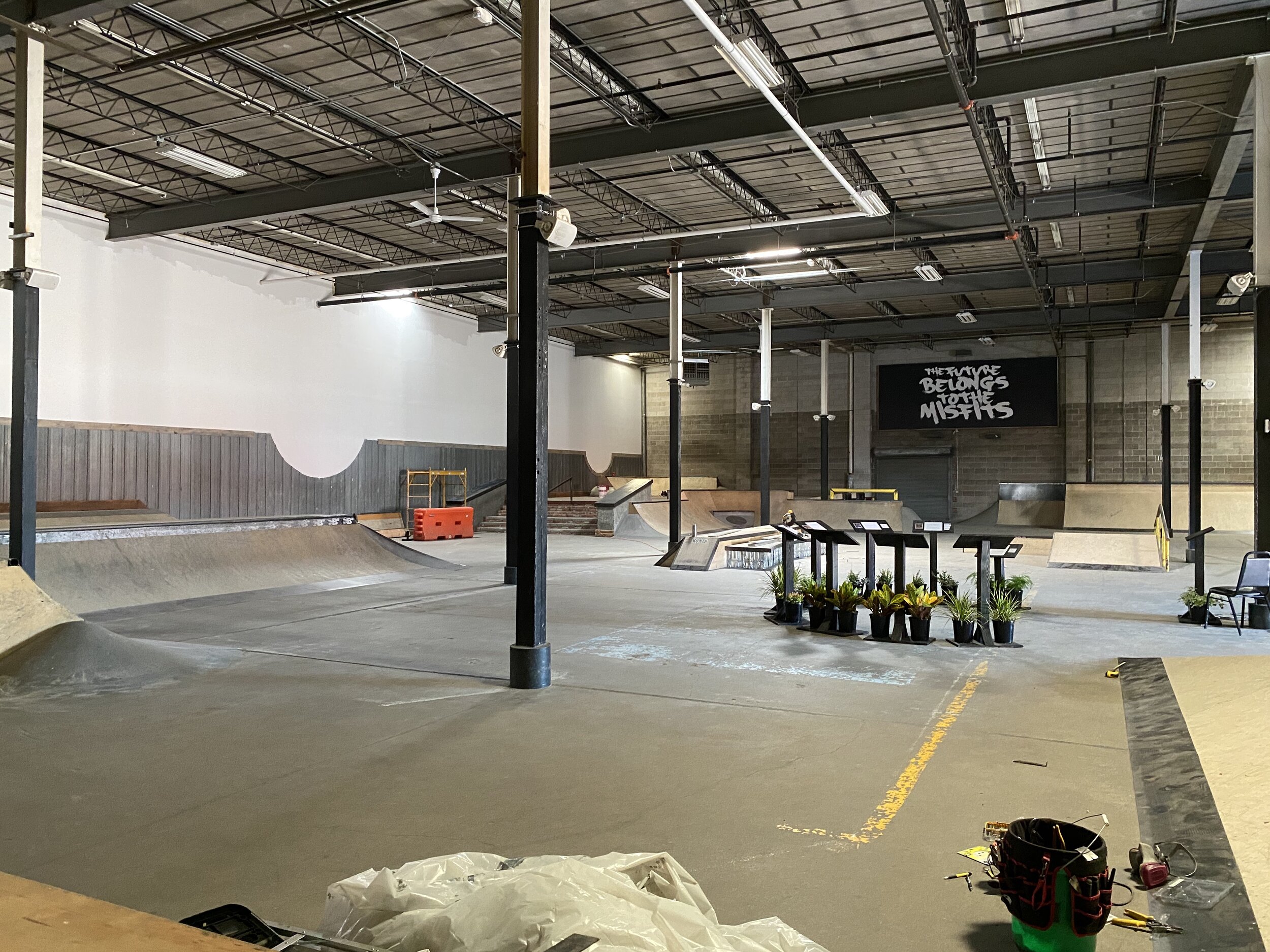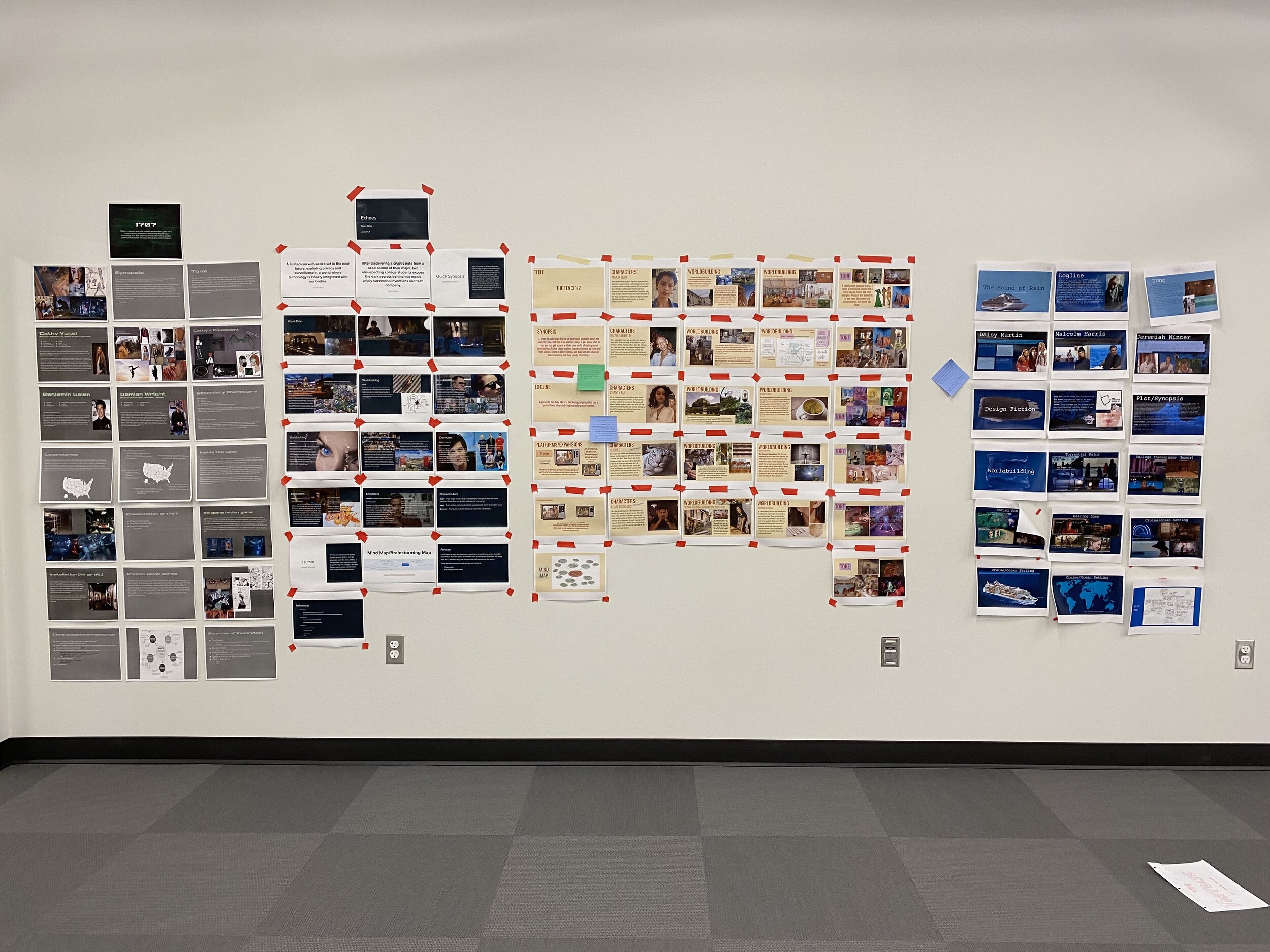Concise. Daily.
Want to make sure you don’t miss any amazing stories? Subscribe to the Daily Journal digest. You choose when to click thru to the full entries.
A Turning Point
Mt. Hood and the White River
With the holiday weekend upon us, I spent yesterday completing the Oregon Trail portion of my travels and picking up the Lewis & Clark Trail. It was a turning point in my journey as I finished the westward portion and am now heading back to the east.
I started my day in Oregon City, which was the capital of the vast Oregon territory and home to the End of the Oregon Trail interpretive center. Because of COVID-19 restrictions, it was closed but the welcome area open to the public had an enticing amount of information enough to wet my whistle.
Departing from the Route
Upon the recommendation of producer Troels Adrian, I ventured off my planned route to stop at the Barlow Road. This was a final treacherous stretch of the Oregon Trail that required ropes to steady the wagons and careful driving. You can walk an original stretch and drive on the modern stretch.
Coming around Mount Hood, I entered the Hood River valley, aka the Fruit Loop, which is home to all kinds of fruit trees and produce farms. The town of Hood River is a foodie’s delight and a popular destination for wind and kite surfers. I grabbed dinner and beers to-go from the Pfriem family brewery.
An Ancient Superhighway
Knowing I was at the transition of the Columbia River gorge where it goes from lush green to high desert brown, I doubled back east to Cascade Locks. Here is the iconic Bridge of the Gods modern structure which is at the point in the river where the indigenous stories recount what happened during the Great Lake Bonneville deluge. You might recall the modern bridge from the Reese Witherspoon movie, Wild.
With those images captured, I hit the interstate west navigating the Columbia River gorge with stops in the Celilo Village and the Stonehenge replica in Maryhill. I kept rolling east until I arrived at my reserved parking spot at my brother’s house in Kennewick. Unloading my gear, we cracked some of the beers and then slept under the stars in our backyard tents.
Reconsidering the Narrative
Thinking about my time along the Columbia River, I can’t unsee how this has been a super highway of commerce for thousands of years. The only difference now is the layers of technology that have covered over the indigenous ways of life. Dams, locks, railroads, interstate roads, and farming operations. What price progress?
It is interesting to reconsider how I view these routes heralded in American history books as accomplishments of the men who documented them. However, they did so with the help of the people who were already there. The routes and trails bear the names of the recent arrivals, not those who arrived thousands of year before.
What roads and routes do you live by that have many layers of culture?
Not the First
Driving from Eugene to Portland, I followed the Willamette River through lush, verdant terrain. This is the farmland that attracted so many to travel across the Oregon Trail in wagons across the plains, mountains, and high desert. Often overlooked in the classical heroic settler story is that people have been living here since time immemorial.
As I shared early in this journey, the human mind seeks compelling narratives. The power of story is undeniable, so it’s a natural extension of that logic to say the power of being left out of stories can be devastating. In talking with the four people who I spent time with yesterday in the Portland area, that became abundantly clear.
My series of three interviews started with James Alan Parker and Se-ah-dom Edmo. He is Chippewa Cree and the executive director of the Oregon Native American Chamber. She is Shoshone-Bannock, Nez Perce, and Yakama and serves as the executive director of the MRG Foundation. Both are working to help the indigenous communities navigate the compounding effects of COVID on what has been hundreds of years of crisis.
I then headed over to talk with Tory Campbell, who is the director of economic development for Portland Prosper. His wife and he also operate their family business, Felton & Mary’s, that celebrates his grandparents, who had operated a beloved restaurant in southeast Portland. Tory has helped lead a dramatic shift in how his agency is helping businesses in the city recover and innovate during this disruption by emphasizing equity for minority-owned businesses. He’s an avid urban farmer with an impressive array of chickens, bees, and backyard garden beds.
Rounding out the interviews, I joined Amanda Squiemphen-Yazzie who is of the Federated Tribes of Warm Springs and serves as campaign manager for Carina Miller, state senate candidate. Her two sisters and she have launched the Chuush Fund and are raising money to provide cleaning drinking water to the Warm Springs reservation. She squeezed in our conversation ahead of a Black Lives Matter protest happening in Portland today, which will bring together Blacks, Indigenous, and People of Color (BIPOC) to reclaim the space of a city park named after George Armstrong Custer.
I finished the day picking up my son’s possessions from Troels Adrian, who serves as one of the 118 producers this real-time documentary and was kind enough to go to Eugene weeks ago to clean out Ethan’s dorm room. We feasted on a very tasty vegan meal from a neighborhood food cart and ate in the light of sunset on the Sellwood Park bluff overlooking the Willamette River and the Portland skyline.
What became clear to me in all these conversations is that a solidarity has emerged amongst marginalized communities and leaders from those communities have risen to leadership roles within organizations that make a direct impact on the complicated issues that have been compounded by the pandemic. It gives me hope for this moment we’re living and for the good that rise from it.
What do you know about the indigenous people of America? What do you know about the marginalized communities of color? How can you educate yourself to understand their challenges and how they connect to yours?
From Sage to Pine
Dee Wright Observatory at the summit of McKenzie Pass
Starting my morning yesterday interviewing Dana Whitelaw was invigorating. She leads the High Desert Museum in Bend, Oregon, and visiting her was a fitting way to transition from spending the past few days amongst the arid plateau breathing in the sage before rolling into the lush coastal valleys filled with evergreens and rivers.
She and her team provide the public with an amazing interactive interdisciplinary perspective of the lands, peoples, flora, and fauna that make up the High Desert. Two exhibits stuck out. First was the wing dedicated to the Native Americans who have resided on the plateau for ages. The second was a technological cornucopia for the senses that is Burning Man.
Museums are having important conversations because of the racial injustice conversation that has come to the forefront in recent weeks. They are natural convening points for people of divergent opinions. So how does one tell the story of a vast stretch of land in a way that acknowledges its complexity and challenges?
I cut across to Eugene along the McKenzie Pass and McKenze River before arriving at the University of Oregon to claim the bicycle my son left on campus when he went back to Atlanta for Spring Break. It turned out I had to stay overnight here and try again this morning (successfully).
Colleges and universities are empty and leaders there are trying to nail jello to the wall when it comes to figuring out how to adjust their well worn playbook for the Fall semester. The meteor’s shadow looms large and the acceleration of the disruption will play out soon enough.
As for now, I’m glad I have reclaimed a bicycle and met a new friend, Mario Tucci. He is a multi-faceted artist in Eugene who is going to jam with us in the coming weeks.
Collaboration for Survival
Boren Family working their ranch near Oreana, ID
I finished my trek across the High Desert with an early rise in Twin Falls, ID, which is where Evel Knievel attempted to jump the Snake River canyon in a steam powered rocket. Three interviews in three towns filled my day.
Starting with an interview of my own with Garrett Hottle of KMTV news station, I then interviewed Liyah Babyan and her son Dominic. She came to America at 10 years old with her family who were resettled from Azerbaijan to escape the ethnic cleansing and war. Her family owns Ooh La Lal Boutique and she is a community leader helping those in the refugee and immigrant community.
After a brief photo stop at Perrine Bridge, I made my way to near Oreana, ID along the banks of the Snake River to spend time with Steve Boren and four of his six children as they tended to their cows and calves. Personal freedom and responsibility are important to them, which is a survival strategy living in a place filled with things able to kill you.
Driving along the Birds of Prey National Refuge, I made my way into Boise to interview Laura Kendall, who leads the Morrison Center for the Performing Arts at Boise State University. The pandemic has shown how vulnerable this sector is and led to more local collaborations with artists.
I grabbed dinner and a beer with one of our 118 producers, Dr. John McGuire, and his friend Mel before continuing along the Oregon Trail and then on the cut thru to Bend, Oregon. Tracing along the final stretch of the High Desert, I entered into logging country in time for a late check-in. My nose detected the shift from sage and lush irrigated farmland to the pine scented mountains.
Falling asleep, I reflected on the different ways people living in the High Desert work together to overcome the adversity of their environment. Just like every human who has inhabited this vast stretch of North America.
How are you collaborating in your community?
Desert Detour
Tree of Utah sculpture
My time in Utah deepened my appreciation for the technology innovation scene that stretches from Salt Lake City to Provo. I met with entrepreneur and early seed stage investor, Sid Krommenhoek, who pointed out the similarities between the region and another global tech hub, Israel.
After we spoke, I headed west on I-80 off the planned route to hit a 3-for-1 detour: Tree of Utah sculpture, Bonneville Salt Flats, and the casinos just over the border in West Wendover, NV. The extra 1.5 hours of driving and nighttime foray across the Great Basin was worth it.
I drove in the wet marshy flats near the sculpture and on the dry flats near where the land speed records are set. Very surreal environment filled with sensory delights. The smell, the dryness, and the crunchiness.
Then I grabbed takeout from The Montego Bay casino and came out even between the slots and blackjack tables. The casinos take COVID seriously with required masks and infrared temperatures checks.
As I drove through the dark, I stopped to take a low light exposure of the waxing gibbous moon. Hitting my pillow at 1am, I girded for the 6am alarm clock knowing it was worth it.
Parallel Approaches
Eleven hours of road time across southern Wyoming and into northern Utah was the bulk of my day yesterday. I drove on I-80 in parallel to the Transcontinental Railroad and Mormon Trail, while the Oregon Trail ran in a distant parallel farther north.
The winds were gusting 40+ mph and traffic slowed to a crawl where one semi-trailer sheared open another with their goods flying to the wind. Traversing this unforgiving land by foot, with push cart, on horse, or covered wagon must have been grueling.
After filling my tank at the Little America travel oasis (yay 75 cent ice cream cones), I raced sunset and cold rains to make it to the Golden Spike National Site in the isolated Promontory Point. Seeing the historic rail grades and imagining that glorious photo opportunity made this Omaha kid smile ear-to-ear.
I’ve made it into the mountains and will spend the next couple days here in Utah and Idaho before entering Oregon. The big thought on my mind is what can we learn from the parallel approaches those who came before us took to over their own big challenges.
The Native American peoples who lived here faced a seismic shift. The Mormons pilgrimaged from near and far to their Land of Zion. Settlers of all stripes and types streamed through these valleys and mountains seeking land and opportunity. All of them faced diseases and viruses that ravaged them, too.
Yet, here we stand. We are the heirs of those who overcame and persevered.
What lessons can we learn from those who had parallel experiences?
Railroad Town Theory
Union Pacific rail yard and main line, Laramie, WY
Having lived in different places across the Midwest, Northeast, and South, I have experienced a mix of community cultures. Since many of them were born from rails, I have a theory about railroad towns.
There’s something about towns and cities that owe their creation to the railroad. They seem more open to new arrivals.
There’s no science or data behind this. Just observations that railroad communities appreciate their dependencies and their role in the circulatory system of commerce. Perhaps that hypothesis extends to Interstate exists, as well.
The American Dream is Alive and Well
The weekend is mostly for chores and footage review, but yesterday I had the chance to interview Amandeep Pandher. Her husband, Mintu, and she are immigrants from India who own five truck stops and their own fuel shipping truck fleet. She’s also weeks away from welcoming their third child into the world.
I found them thanks to my friend Kamal Singh Masuta, who I had the pleasure of working with through a Committee to Protect Journalist’s project. He is a Sikh living in New York City and has helped me learn about his faith community. He contacted the Sikh Coalition who stepped forward to introduce me to the Pandher family.
A few years ago, I read an article about how the trucking industry has attracted a large number of Sikh immigrants to help meet the market demands for drivers. Truck drivers are the foot soldiers of the supply chain and the profession attracts entrepreneurial types. It’s an essential service.
As more have become successful trucking company owners, some have begun to see the market opportunity to meet the growing number of vegetarian drivers while providing more Indian cuisine options along the interstate system.
I can’t wait for you to hear and see Amandeep’s interview. You’ll see the American dream is alive and well, plus you get to learn more about their formula for success: cheap fuel, delicious food, and compassionate service.
What cultures have you welcomed into your community?
Waypoints and Wyoming
Chimney Rock in Bayard, NE
One week and 1, 730 miles into this journey, I came upon the most iconic landmark of the Oregon Trail. As a native Nebraskan, it took me 47 years to see Chimney Rock with my own eyes and to drive through Mitchell Pass with Scotts Bluff towering over me like an ancient sentinel. I have reconfirmed my birthright.
Like a runner or cyclist passing through a waypoint, you can feel a visceral sense of progress when viewing these milestones. Chimney Rock is the landmark referenced the most in diaries of those who made the Oregon Trail trek. Arduous journeys require emotional rewards and Chimney Rock doesn’t disappoint.
Casper Connection
Thanks to my friend, Amanda Thompson, I deviated from my planned route to continue along the Oregon Trail instead of going back to the Transcontinental Route. She’s a native of Casper, Wyoming and suggested I talk with the couple who live across the street from her family home.
If you’re scoring from home, you might have wondered why map pins on the Data Dive paged started to show up way off the advertised route. Opportunity plain and simple. The chance to talk with a trauma program manager and paramedic was reason enough Throw in an introduction to their friend who owns a beauty salon and it was a slam dunk.
They recommended I drive up to a lookout point on Casper Mountain for a view of the stunning vista. By the time I shot some local b-roll footage, I set up just in time for sunset. With a blue sky and knife edge cloud bank, I couldn’t have scripted it any better.
Wide Open Sky
I grabbed some road food from Taco John’s (turns out it was started in Wyoming) and headed south in the dark to Laramie. I got about 20 miles outside of town when I realized I did not have enough gas to cross the sparsely populated route, which commemorated the path taken by the Cheyenne and Arapaho people following the Sand Creek Massacre carried out by the US Army in 1864 in what is now Colorado.
By the time I returned to Casper and filled my tank, I was treated to a very dark, clear sky journey. I stopped along the way and experimented with the iPhone 11 Pro’s longer exposure time option. It felt like my own personal Hubble telescope, which happens to also serve as my Audible player of Lewis & Clark’s edited journals (to help prep for my return trip).
Major and Minor Ursula taken north of Laramie, WY
Reflecting on the Wyoming Way
The spirit of the cowboy is alive and well in Wyoming, which has the official moniker of “The Cowboy State”. My two interviews in Casper attested to that. I can’t wait for you to hear what they shared. The gist is that people in Wyoming are fiercely independent and sometimes recklessly so. For example, they don’t have a primary seat belt law here.
You can’t break horses, ride bulls, and create wildcat oil empires without self-determined people. Casper is an oil and gas town and has the largest hospital system in the state. Cari and Milton Hacking see the Wyoming Way first hand, since she is the trauma program manager and he a paramedic. They’ve see how this cowboy spirit comes out in tragic consequences, while also seeing how it comes out in beautiful expressions of humanity.
Tiffannie Piaia owns her own beauty salon and teaches part-time at the adjacent beauty school. Originally from Utah, she has lived in Casper for 12 years and until the pandemic broke out loved traveling the world. She shared with me some insights about the important role rodeos play in Wyoming.
Want to Help Me Out?
If you want to help support Project Tumbleweed, you can contribute to the Compass Club with whatever you want to kick in. You can buy me a coffee, help fill my gas tank, or cover a night in a hotel room. Big thanks to Lisa Wilson, Jessica Kennedy Matthews, and the Hacking Family who contributed without me even asking.
Another great way to help is to share and promote our social media content. You can help us grow the audience and keep the tumbleweed moving down the highway. However you can help, I’m very grateful to you.
How would you describe the mindset of your home state?
Crossing into the West
California Hill looking southeast towards the Platte River
For those of you who only see the interior of the United States from an airplane, it might surprise you to know there are nuances of culture for those people who live here. I learned that the summer I worked as the recruitment chairmen for my college fraternity driving 10,000+ miles in my car across the state of Nebraska.
Leaving Lincoln heading west, you begin to melt from Midwest to the West. It’s right about where the precipitation patterns drop enough to switch from farmland to cattle grazing. Of course, central pivot irrigation drawn from the Ogallala Reservoir has opened up more farmland, but the ethos remains the same.
The landscape is more rugged and punishing especially when a thunderstorm or snowstorm rips across the Plains. You can see its inevitability coming your way. Ominous and humbling. This attracts and retains a different type of person. The cowboy and cowgirl ethos. Knowingly enduring this harshness and willing to accept the risk.
Ancient Migratory Paths
I enjoyed my stop at Fort Kearny Historical State Park, which is a replica fort built on top of the original. It served as a US Army post protecting Oregon Trail and other westward travelers. Some landscapes were destined for migration. Ancient game paths now layered with humankind’s. What is now called Kearney, Nebraska is one such place.
The Platte River (inch deep and a mile wide) attracts seemingly infinite numbers of migratory birds, including the Sandhill Cranes. Within a short distance are the Mormon Trail, California Trail, Pony Express, Oregon Trail, Overland Stagecoach, Transcontinental Railroad, Lincoln Highway, Interstate, and fiber optic.
Honoring Those Who Were Here
All of these followed variants of pre-historic game trails learned from the Native Americans who were the original inhabitants of this vast land. You and I use their place names and other words all the time without taking notice. Nebraska, Iowa, Dakota, and Kansas just to name a few.
Maybe it is time we should learn and honor their stories. I don’t plan to celebrate the Manifest Destiny narrative in this documentary. Rather, I plan to view it in its holistic impact on those who were already here and those who have come since - the good and the bad.
Cycles of Life
Stopping in North Platte to interview a man who I had recruited 28 years before from that same town to join our fraternity was fascinating. We had both lived longer than we were aged at the time of our first meeting. He’s a native of North Platte and you’ll enjoy what he shared about the unexpectedness of 2020, including losing his mother to cancer during the COVID pandemic.
We discussed the nuances of eastern and western Nebraska culture, since he spent a fair amount of time living in Lincoln and Omaha. As he said, ranchers have been social distancing forever. There are differences.
Road Food and Roadside Attractions
I snuck in stops at Runza (it’s a Nebraska thing) and the world’s largest rail yard run by the Union Pacific on the Transcontinental Railroad line in North Platte. Then picked up a to-go order of Rocky Mountain Oysters from the iconic Ole’s Big Game Bar in Paxton.
As sunset approached and a raging thunderstorm passed to the north, I rambled up the best stretch of the Oregon Trail for wagon ruts. California Hill at sunset with a storm nearby made me glad I had my Subaru not an open wagon. The kid in me was filled with electric glee.
What’s a surprising nuance about the part of the world in which you live?
Beginner’s Mindset
My last morning in Lincoln, Nebraska after taking an extra day to sift through the 12 interviews recorded to date. That was quite the initial burst of content that has given me insights on how to streamline my efforts while improving the quality of the yield
Yesterday, I posted the 1-minute teaser video and promptly got a text from mom with motherly advice about how to make it better. At first, I bristled but then remembered two things: 1. she was saying it out of love and 2. I’m a self-taught documentary producer so I need to keep learning from feedback regardless of the source.
Scrappy Underdog
Having the Beginner’s Mindset, aka the mind of a child, is a wonderful way to keep growing throughout your life. I have always felt like the underdog, the overlooked, and the easily dismissed. Maybe it’s because I’m a younger brother. Maybe it’s because I’m from Nebraska smack dab in the middle of flyover country.
Yet, that’s been the secret to my successes. I have always felt like I was destined to make an impact in this world. Not out of grandiosity but because I understand my unique strengths and how I can move mountains with the help of friends.
This inner determination has served me well when I’m open to the feedback others give me. It can be outright stubbornness when I shut down.
Embracing Real
In reviewing the footage (five down, seven to go), I realize staying open and self-aware will be critical in this endeavor. Yes, I was a bit winded in my teaser video, but I chose to leave that as is. This real-time documentary is about telling an authentic story of life in America with all its conflictedness.
Why pretend I’m some professionally trained filmmaker when I’m not? Why not let the world watch me learn and grow through this journey? Why not embrace the lessons I learn instead of ignore them?
Decisions, Decisions, Decisions
My current dilemma is what to do with all these interviews. I’m pulling them apart to find the threads and gems that can be woven into a coherent, engaging narrative. Traditional documentaries shoot all the footage and then assemble. I have chosen to create in a serial, open-ended format.
That means, I need to figure out a narrative spine for each episode, not wait till this is over when I have the 20/20 vision of hindsight. This excites and scares me, which means I’m right where I need to be.
The other dilemma is how to break up the six episodes. Is sixty minutes enough time to share the 20 state journey? Or do we need to raise more money to bump this to nine episodes/ninety minutes? We’ll see.
Back to the Road
After a nice respite in Lincoln (thanks to to producer Jeff Moran and his family), I’m ready to hit the road and pick back up in western Nebraska where the Transcontinental Railroad and Oregon Trail will take us West from Kearney to Salt Lake City via Wyoming.
From the midwest to the mountain west.
What advice would you give me as I move forward?
Share Far and Wide
The Trailer Video:
Thanks to VidLoft for the quick turnaround on this. I’m excited to share it with you and would love it if you could share it far and wide.
Please share this trailer video link far and wide! It gives you a taste for what’s coming your way. Here’s suggest copy to use:
I thought you might enjoy following this real-time documentary about life in America during a pandemic. This guy is traveling to 20 states over 4-5 weeks talking with people from various perspectives to see how they are dealing with this moment in time. Here’s the trailer: https://youtu.be/8oavM1jS1kM and the website is www.projecttumbleweed.com.
Some Glimpses:
A Bit Deeper Dive:
This morning, I sit in downtown Lincoln, Nebraska just two blocks east of the state capitol building. It’s good to be back in the city where I stepped into the world twice. First at birth and then again while at the University of Nebraska-Lincoln. Has it already been twenty five years since I graduated?
In talking with Daniel Roberts of VidLoft yesterday, I was reminded how deep of an ocean I’ve dove into with this project. I feel that reality every day knowing that I have taken on a great challenge with a high degree of difficulty. This isn’t coming from hubris or vanity, though.
The Importance of Relationships
Rather, I confidently dove head first because of the high-quality network of friends, family, and colleagues who have joined me in this endeavor. We’re living through a watershed moment in human history and no one knows how it will end. It’s encouraging to me knowing I have people cheering me on and fueling my success.
Interviews Filled with Gems
The rest of today and a good chunk of tomorrow, I’ll be sifting and sorting through the first 12 interviews so we can begin to edit and arrange the first episode. You’re going to love hearing what people have shared with me. There’s some powerful feelings and ideas.
One thing is apparent: Project Tumbleweed is creating a unique library of videos, photos, data sets, and audio clips. I am formulating some ideas for how to make these assets available to content creators and storytellers who want to collaborate.
What’s accumulating in this library reminds me of when the Works Progress Administration sent folks during the Great Depression across America to collect folk music and stories. I don’t profess this to be on that scale, but this is a rich vein of human insights.
What are you most interested in learning about through this documentary series?
The Burden is Real
Memorial Park, Omaha NE: Honoring those who lost their lives in World War II, including two of my ancestors.
We as humans define ourselves by the stories we tell ourselves and share with others.
I am ten interviews and four states into this. Half are people I didn't know. All of them are trusting me with their personal stories about the most disruptive experience in their lives to date.
What will happen to these stories through this documentary matters. It can help everyone make sense of the confusion and uncertainty. I feel the burden and responsibility on my shoulders. I am ready for this.
After today’s interviews in Lincoln, Nebraska, I will spend 36 hours sorting through the footage and begin to select what we will use for the first episode and what we will share was field clippings. I’m excited for that.
More to come your way each day. Until then, hold the hope.
What stories do you keep that honor others? How do you pass them down?
Walk then Run then Fly
Growth requires feedback loops and time to consider lessons learned.
Now that I have moved out of Indiana and am officially nomadic, I took time today to get myself better situated. That started with unloading my worldly possessions at my parent’s house so I can have more room to operate for the next few weeks. It gave me time to consider what lessons I learned after a full Saturday.
Never underestimate how much time moving takes. Especially when you’re launching a major project. Boy that was a higher level of difficulty and stress than I expected.
Focus on the core content and then layer. I have grand visions for how this real-time documentary will look and have some pretty exciting experiments planned. But I gotta focus on these first few steps and get myself in a productive rhythm.
The marathon has started and now the mental discipline becomes key. While it might seem like a one-man show, there’s a robust network of people who have funded my launch, promoting the production, and helping me line up interviews. I owe it to them to make sure I “chop the wood and carry the water” every day.
This content can’t wait. The world is changing too fast. After just six interviews, I’m itching to share these stories. I’m not going to wait until we have polished the gems and arranged them in Faberge eggs. You didn’t just show up to the movie. You get to watch it get made in all its messiness and complexity.
Better safe than sorry. With the upward trends of infections in the states I’m traveling through, I need to be safer than even planned. I’ve decided to get tested weekly even though I have no symptoms and no known direct contact. Plus, I’ll keep masked anytime I’m inside and in close quarters.
What do you want to know I haven’t shared yet? What thoughts and suggestions do you have?
The Journey to the Find the Story Begins Now
Every great story requires a central conflict. And the last thing you want to do when embarking on a journey to create a documentary, let alone a real-time documentary, is not start with a thesis. (Thanks, Andy Stoll, for that advice.)
Plus, you have to know what you believe. That way, you can go boldly with ears, heart, and eyes open to find the real story once it emerges. Have a thesis and then test it with reality-based observations.
My Initial Thesis: Resilience and hope will get us through the pandemic
I believe COVID-19 heralds the beginning of a new era, which has tested us and will continue to test us, individually and societally. However, we are not the first in human history to face great challenges, nor will we be the last. By traveling the United States around 100-125 days into this era, I will find stories of resilience and hope that will provide us with lessons for how we can move forward.
Belief 1: Narrative matters
The human mind loves stories. Data move the mind, stories move the heart. Ever since the days we painted images in caves, we have been leaving stories for others to find. Narratives give us ways to make sense of what can be a confusing and overwhelming world.
Belief 2: Travel sparks new insights
A list of great books and stories about people on an adventure would have to be quite lengthy. From Homer’s The Odyssey to On the Road by Jack Kerouac, we have many choices. I remember reading Blue Highways: A Journey into America by William Least Heat Moon in high school and saying, “I’d love to travel across America one day and tell stories about the people I met.” It took him five years to figure out how to weave his masterpiece. Let’s see what we can pull together in five weeks.
Belief 3: Honor those who came before
You’ll get a chance to travel along segments of historic and pre-historic trails. This is an intentional approach on my part to make sure you and I recognize the First Nation peoples who have lived tens of thousands of years in what is now the United States. Their voices are as important as the settlers who came from other lands.
The Transcontinental Railroad, Oregon Trail, Lewis and Clark Trail, and Natchez Trace each offer insights about the various people who have traveled along them. Especially because of the many layers of culture those who have passed through them left behind for us.
Belief 4: The landscape shapes us
The physical world molds our minds. Moving in the three-dimensional realm, we create mental maps and metaphors that serve as foundations for our worldview. I wrote a poem the first time I walked where the Tippecanoe River and Wabash River meet in Prophetstown State Park near Battle Ground, Indiana, which hits on this theme:
The Central Conflict: Fighting my own bias
As your guide, I will fight daily with the need to honor each person’s belief of the truth, regardless of my beliefs. I will struggle to challenge my own beliefs and stay focused on what is, not what I believe/want it to be.
We are surrounded by the Outrage Media Complex. This means each of us have hyper-polarized media clouds customized based on our social and interest graphs influencing our perceptions.
To prevail, I will need to recognize that whatever I think, the person I’m interviewing believes their perspective is the truth. I need to honor that truth. Big thanks to David Seeney from Fresh Behavior Media for that insight.
What do you think? What needs to be added? Where am I wrong here? What blind spots do I have?
My Gear
Every journey requires gear. I bet you’re wondering what a self-taught documentarian takes with him. Here’s what I’ve chosen to shoot a real-time documentary about life in America during a pandemic.
Real-Time Documentarian Starter Pack:
VidLoft Mobile Studio
Includes: DJI Osmo Pocket, Rode Wireless Go Mic, Mini Shotgun Mic, Joby Gorillapods, DJI Osmo Accessory Pack, Charging Kit. 2x 64gb Sandisk Flash Storage, Cell Phone Holder for Gorillapod, and Water Resistant Compact Travel Case
Flic Buttons courtesy of WHIN.org
Supplemental Audio, SD Cards, and Cameras
Mavic Pro Drone courtesy of Mike Rendel
Masks, Gloves, and Wipes
Official Road Snacks from Leo’s Wellness Bakery
Not Pictured:
Subaru Outback 2019, MacBook Air, and iPad Pro
What would you recommend adding to this?
How to Play the Game
Hello, world. Want to know what this all about?
Thank you for checking out what we’re doing here with Project Tumbleweed, a real-time documentary about life in America during a pandemic.
20 states. 4 weeks. Many, many miles.
I hit the road this Saturday (June 20, 2020) and hope you’ll join me for the journey. Regardless of when you find this, you might be wondering what you stumbled across.
Here’s a brief introduction to get you started:
What’s a “Real-Time Documentary”? You get to see behind-the-scenes as this story unfolds — you can even help shape the story arc. We’ll post snippets from interesting moments via social media and our daily email digest. You can track Scott’s progress and learn about the states he’s traveling through by visiting the Data Dive page.
What do I seek to accomplish? I’m interested in learning how others are navigating the disruptions that the COVID-19 pandemic has caused in our daily lives. I believe this is a great opportunity to understand how people in different parts of the country are overcoming these challenges and what lessons we could draw from these stories to apply going forward.
How can you be part of the show? You can recommend people with great stories, submit/post your photo for the “Wish You Were Here” challenge, and kick in for coffee and gas to get a shout-out from me. More details on the Contribute page.
Who’s behind this? My name is Scott Henderson. You can read my bio and learn more context about everything on the About page.
How am I going to pull this off? Learn as I go. I have a strong network of supporters who not only helped fund the launch but are contributing many helpful insights and suggestions as I go along. It takes a trusted network and a willingness to learn/stumble along the way. I appreciate your grace if things go off the rails, especially since I’m a self-taught videographer, photographer, or documentarian. .
Special Thanks to:
VidLoft for partnering with me and providing the technical assets to turn my footage around in time so we can have the premiere episode launch while I’m still on the road
Ronlewhorn Industries for creating an amazing design package from digital to print
Shawn Taylor for coding the real-time dashboard and route/journey mapping solutions featured on the website
Ted Smith, PhD, from the University of Louisville, for our research collaboration looking at the mental models people are using to navigate the pandemic
Leo’s Wellness Bakery for serving as the official road snack
Mike Rendel for entrusting me with his Mavic Pro and recommending I buy roof rack storage
